On Humor – Part One
by
John Bonath
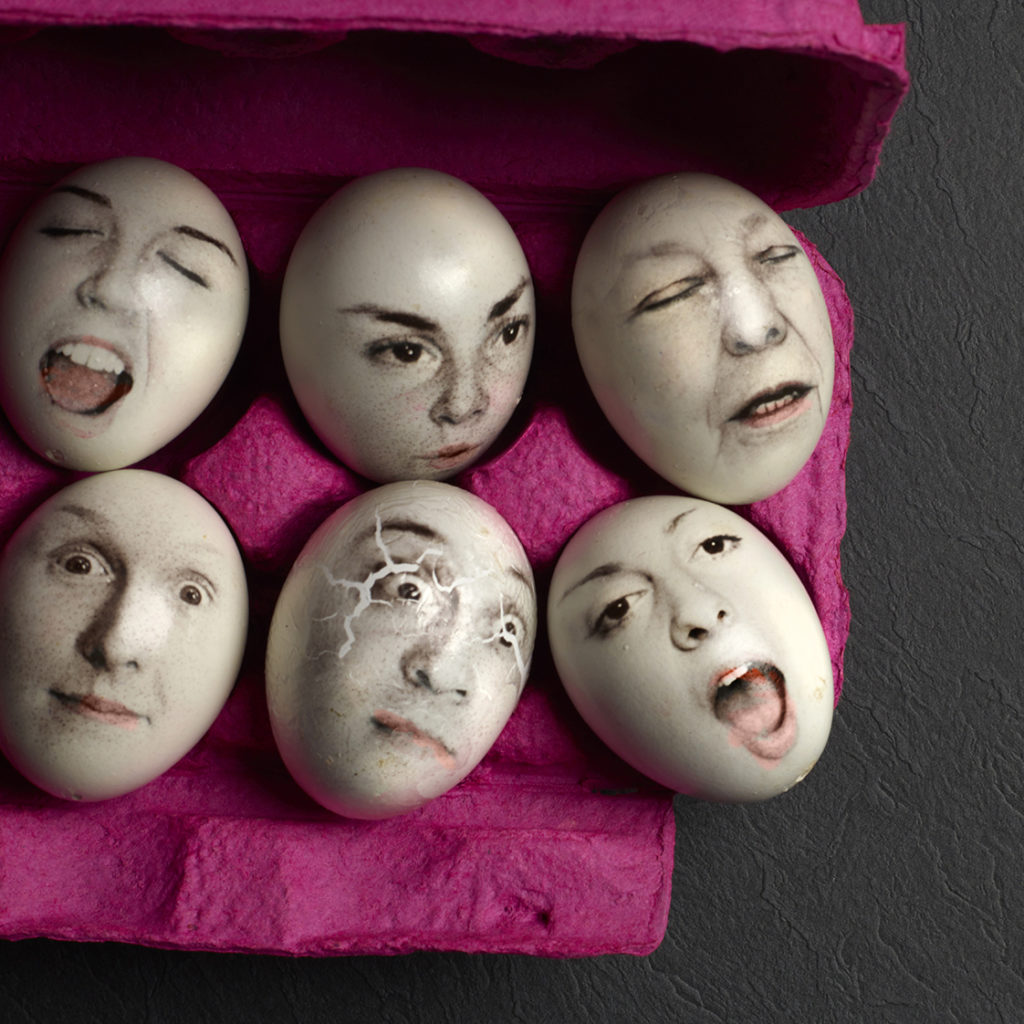

Dedication
This two-part blog is dedicated to my father who taught me the importance of humor. He was a good storyteller and practical joker, had an encyclopedic memory for jokes and lived his life to be a catalyst for smiles and laughter in others. His humorous wit was his coping mechanism, served him well, and did not falter on his deathbed.
Part One
1. On the Nature of Humor
Humor is considered to be an important part of human development and an important basis for one’s well being, though some people cannot process humor in the neuro-typical way. It is an expansive topic, the extent to which depends on a host of absolute and relative variables, including but not limited to geographical location, culture, maturity, education and context.
Humor has many genres and sub-genres such as irony, parody, absurdity, sarcasm, cynicism, whimsy, hate, cruelty, satire, double entendre, profanity, as well as dry humor, wry humor, light humor, dark humor, slap-stick humor, gallows humor, tongue-in-cheek humor, racial humor, dead-pan humor, gross-out humor, bully humor, self-deprecating humor, sexual humor, reality-denial humor, fatalistic humor, then humor can come in many forms such as word-puns, riddles and practical jokes.
Aside from sex humor, the universal humor throughout world history is “flatulence humor”. (Benjamin Franklin wrote a book on the topic titled Fart Proudly and British historians tracked down the world’s oldest joke to be a fart joke from 1900BC.) Another type of humor that has existed in every culture since the beginning of language is the word pun, in which words may sound the same or similar but have different meanings. Political humor has also existed in all civilizations despite dangerous and repressive regimes. Dead-pan humor is an odd one in that it is funny because it isn’t funny or is so obvious that it by-passes one’s radar – such as “Why did the monkey fall out of the tree?” “Because it was dead.” Or the classic “Why did the chicken cross the road?”. A punch line just needs to subvert our expectations or be a surprise. Humor comes in as many flavors as ice cream. It is unique to our species and usually boils down to our need to connect to others as social animals and be liked.
To complicate an understanding of humor even more, perceiving something as funny is relevant to one’s mood and brain chemistry, which can change like the weather. If your mental state is altered by any number of substances, a rock on the sidewalk may be perceived as the funniest thing you have ever encountered. Hearing a laugh in itself, with no context, triggers contagious laughter without even knowing what is funny. Everyone loves a clown, but the life of a comedian is a brutal career. We all know the phrase, “I don’t get it.” In that case, any attempt at an explanation is a catch-22; overthinking is the antithesis of humor; if you have to explain something it negates the spontaneous nature of humor and for sure you “won’t get it”. Humor is often hit-and-miss and often offensive when it doesn’t “connect” or “tickle your funny bone” (or worse yet, one might get hit in the face, live in front of millions, such as at the recent Oscar Awards). The bottom line is that there is no bottom line when it comes to humor.
Two jokes written by Greeks Hierocles and Philagrius in the 4th century:
Asked by the court barber how he wanted his hair cut, the king replied, “In silence.”
Wishing to teach his donkey not to eat, a pedant did not offer him any food. When the donkey died of hunger, he said, “I’ve had a great loss! Just when he had learned not to eat, he died.”
A riddle from Ancient Greek Sophocles:
What animal walks on four feet in the morning, two at noon and three at evening?
Man. He goes on all fours as a baby, on two feet as a man and uses a cane in old age.
2,800 years ago, Homer indulged in some dark humor when he wrote in “The Odyssey”:
Odysseus tells the Cyclops that his real name is “Nobody”. Then Odysseus instructs his men to attack the Cyclops. The Cyclops shouts, “Help, Nobody is attacking me!”… No one comes to help.

Here are two sex jokes from Ancient Egypt, 30BC:
Man is even more eager to copulate than a donkey. His purse is what restrains him.
How do you entertain a bored pharaoh? You sail a boatload of young women dressed only in fishing nets down the Nile and urge the pharaoh to go catch a fish.
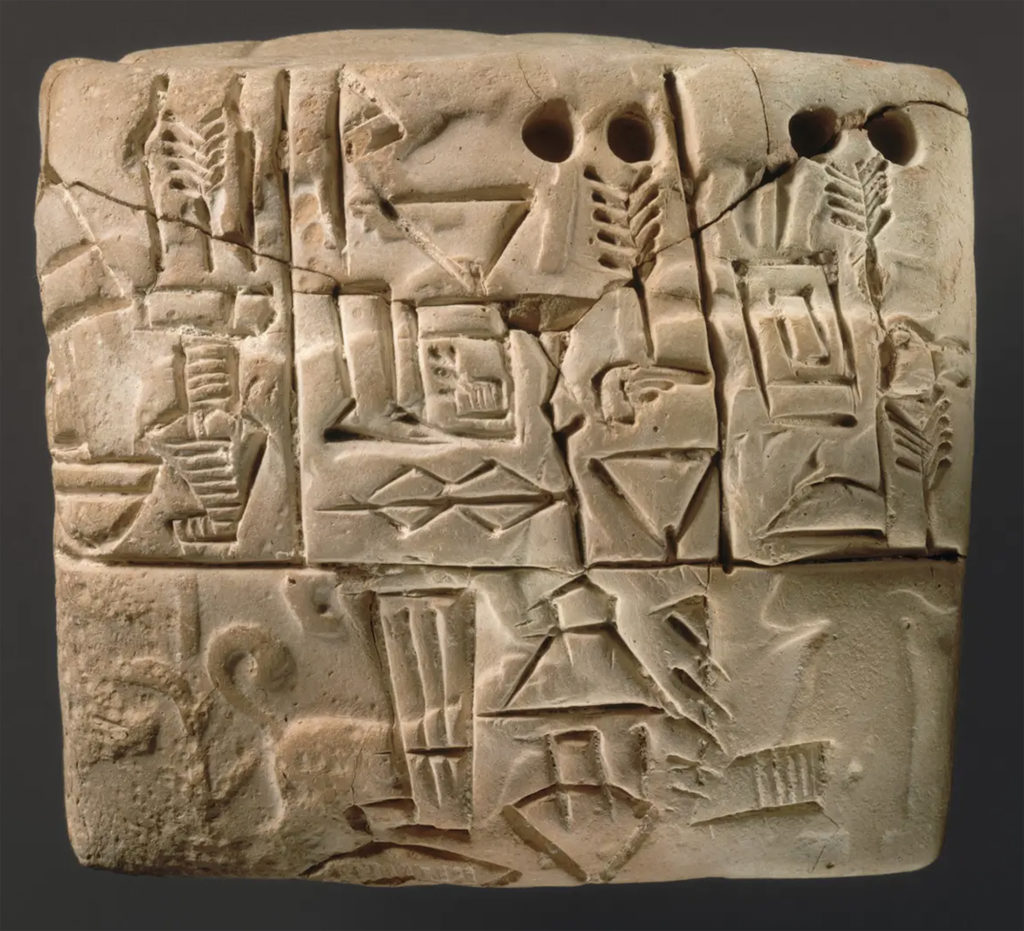
And this is the oldest known joke, from Ancient Sumeria around 1900BC:
Something which has never occurred since time immemorial, a young woman did not fart in her husband’s lap.
In Medieval Europe noblemen and royalty had personal jesters. The tradition of the jester as the official jokester gave them license to poke fun at even those employing them, although it was often a very dangerous and complex position. Even today we can see the tradition of the ever-smiling jester in the Joker character of Batman fame, as a very dark villain who liked to photograph beautiful women for laughs. When he told them to “Smile!”, his camera squirted sulphuric acid into their faces. We think of him as a fictional character but the horrid act of throwing acid into a woman’s face is all too common in India and has happened in America as well. The Joker is a very complex icon indeed.
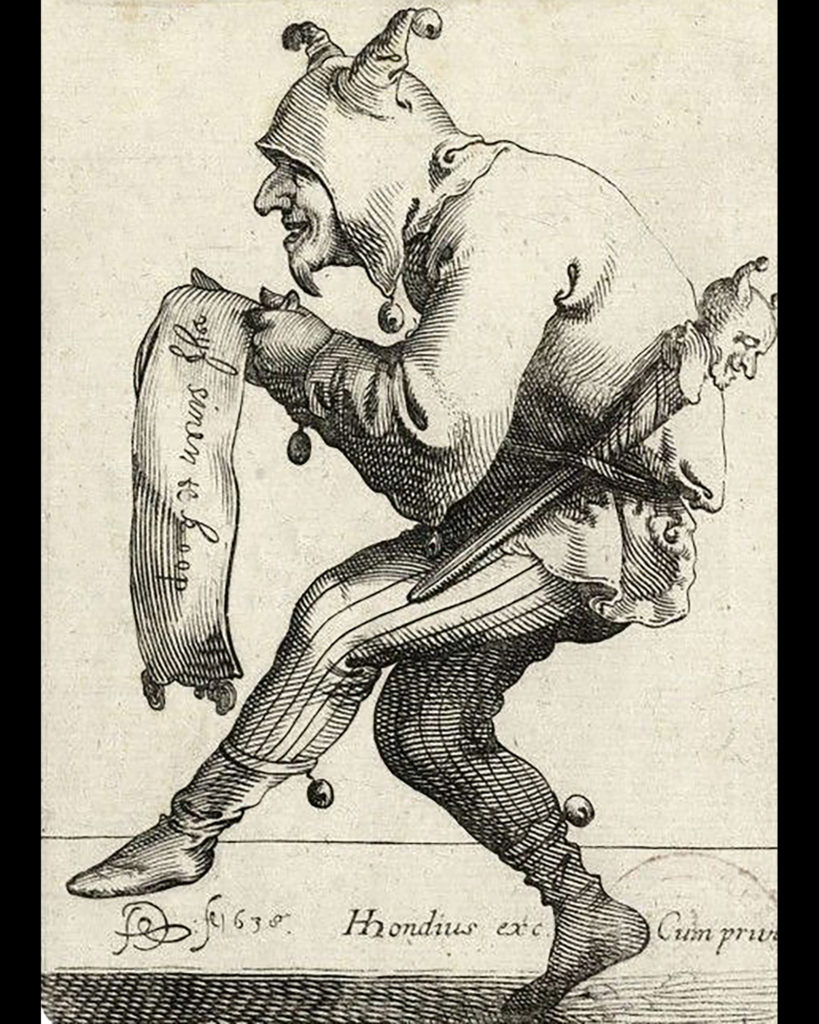
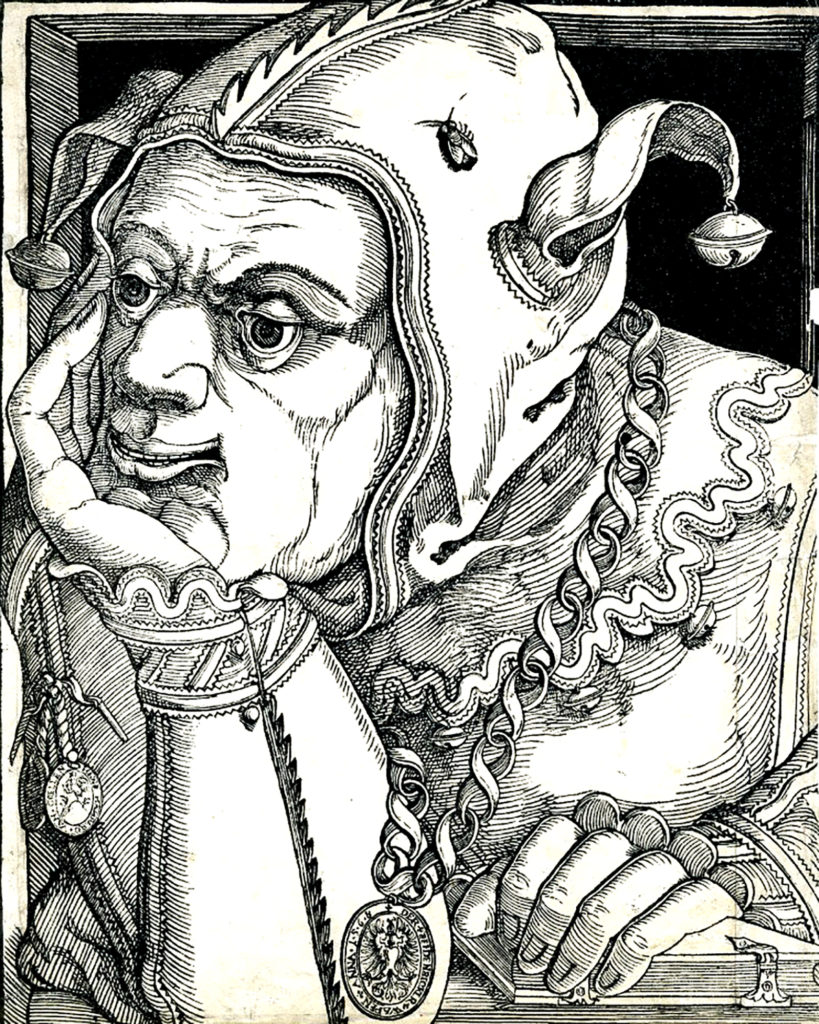
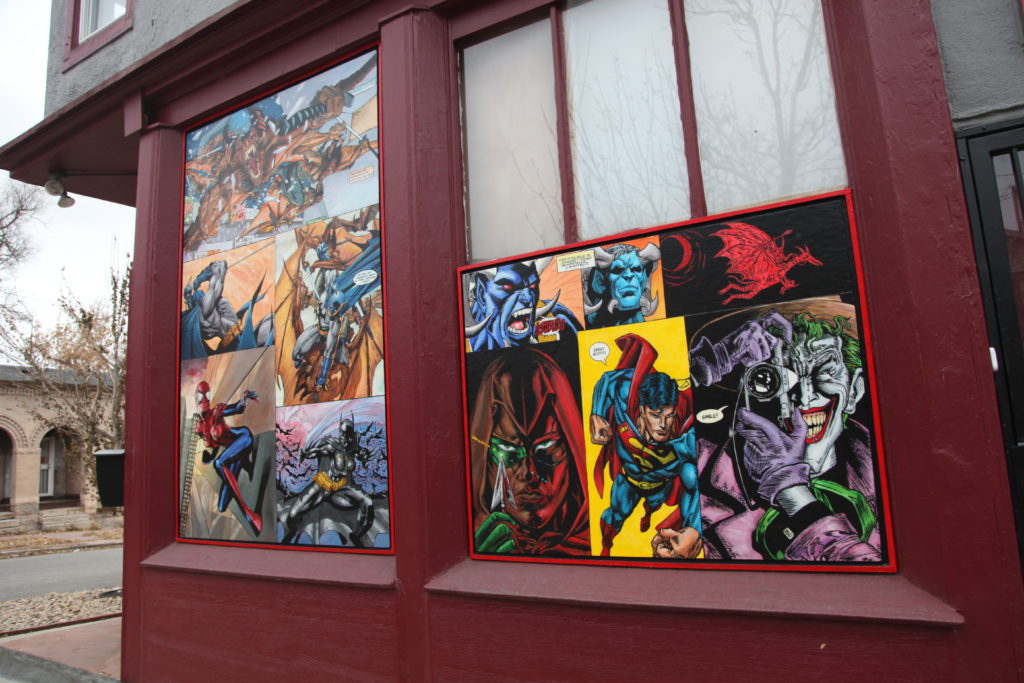

I stepped outside today and was stopped by a young man passing on a bicycle who raved about how much he loved my house and the comic book murals on it. He told me he especially loved The Joker and that it was his favorite character of all time. He said he smiled each time he passed my house and then proceeded to roll up his sleeve and show me a huge tattoo of The Joker on his arm. It is interesting how The Joker has become a legacy in the soul of humanity over centuries.
Each culture has its own tone and tendencies that favor its humor. Here’s a cartoon and a joke from Japan that I found interesting to consider as funny.

There are two reasons why you are single:
first is nobody is good enough for you;
second is you are not good enough for anybody.
And a South American joke that is totally outside of my box to “get”, but it does have the structure of a racial-slur riddle. I can make a wild guess at the logic of this joke, which has no logic, but I find this entire genre of humor offensive.
¿Por qué los mexicanos no pueden jugar billar? Porque se comen los tacos.
Why Mexicans can’t play pool? Because they eat tacos.
Fake news can be a very funny genre – if one realizes that it is fake. But when absurd news and humorously bizarre conspiracy theories are believed, it is a scary thing.
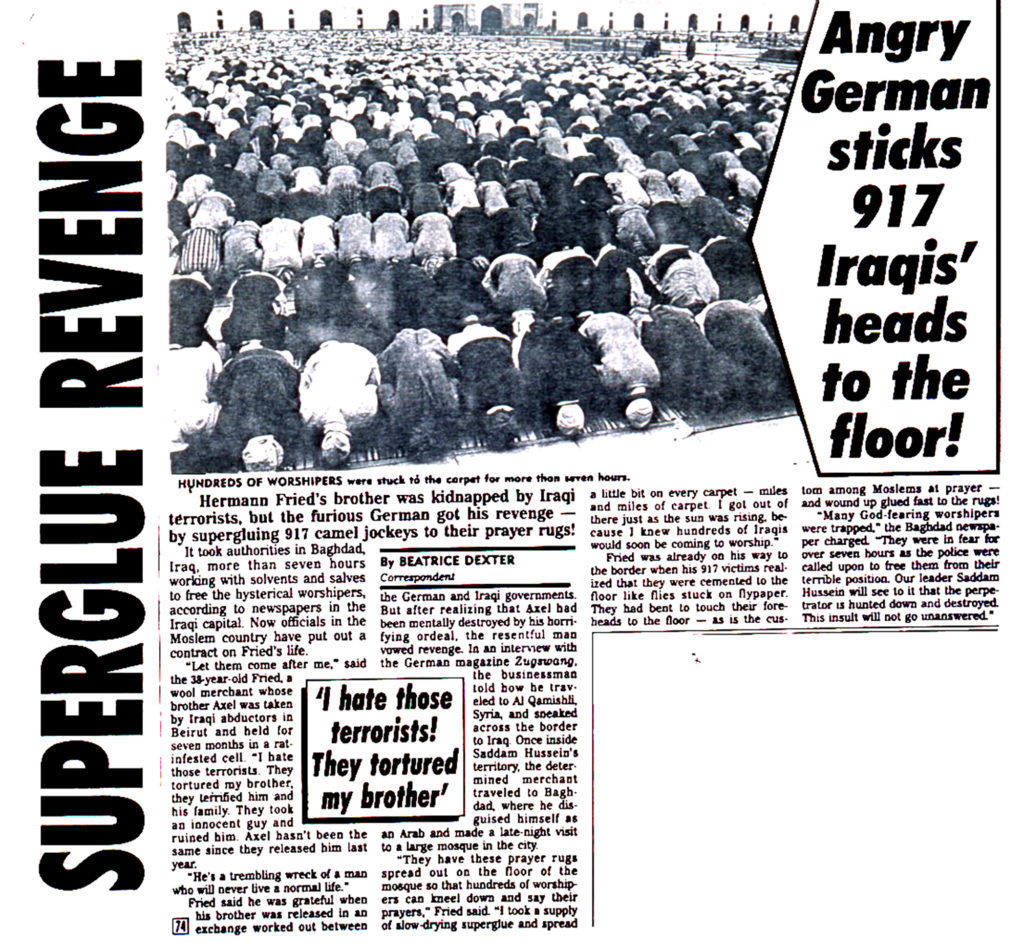

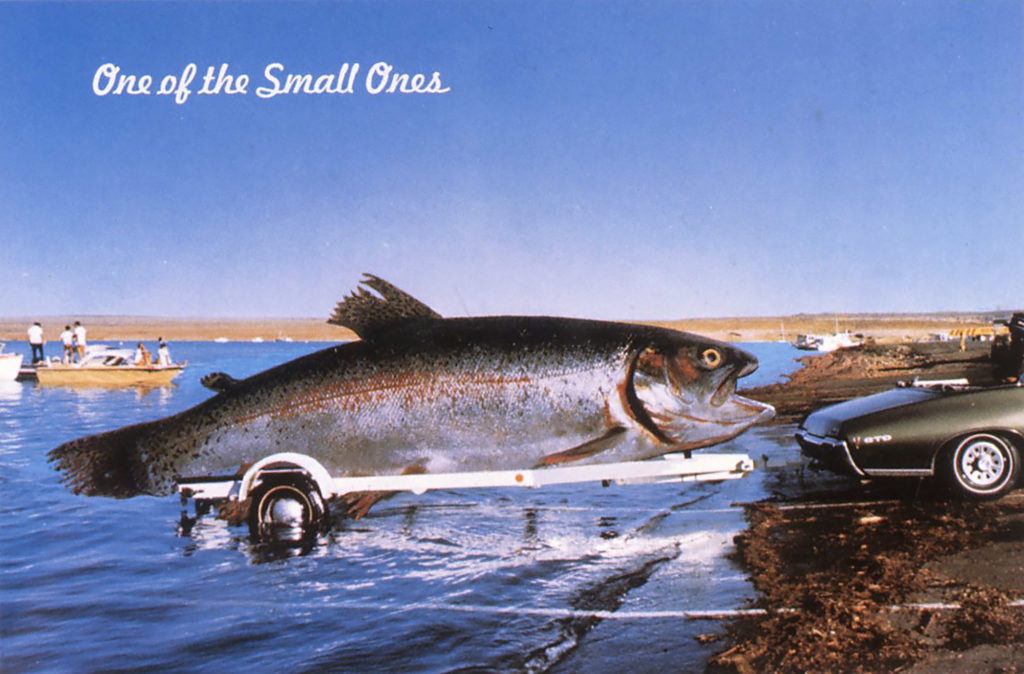
2. The Evolution of My Humor
Humor is an aspect of the way I think and, as with anyone, is predominantly a product of the culture and time I was born into. In my lifetime, popular humor has gone through major transitions. It was still Mutt & Jeff when I was born, then came my formative years of preschool during the postwar era of Bugs Bunny, Howdy Doodie, The Three Stooges and The Marx Brothers . The 1950’s mentality reflected conservative Walt Disney values, which laid the groundwork for a major revolution in humor to rebound off during the cultural revolution of the 1960’s.
During the early years of the 1950’s, I used to play baseball, tag, jump rope, hide-and-seek and another fun children’s game called Ring Around the Rosie. In this game we would all hold hands and skip around a person in the middle as we sang the game’s song- Ring Around the Rosie, Pocket full of Posies, Ashes, Ashes, We All Fall Down. At the end of the chorus, we would fall down suddenly and pretend to be dead. We laid still, attempting not to laugh as the person in the middle ruled on who was the first to move and that person took their place in the middle as we repeated the game cycle all over again. It was great fun! Ring Around the Rosie originated in 1665 when the bubonic plague devastated London. The shape of the “rosie” is the shape of the rash that appears on your skin when you first get the plague. The flowers are used to ward off the stench of your living body as it rots. Then we burn the corpses and we all drop dead. As a child, I knew the story. Perhaps this was the beginning of my dark humor as death was not a foreign experience in my childhood. Times have changed since then though. There are no new children’s games where kids can pretend to die of Covid, but “pandemic humor” is common and is usually on the darker side. Sometimes we just need an excuse to laugh in the face of our own mortality… I certainly do.



A few random samples of current pandemic humor:



In the 1960’s, popular culture changed dramatically and was reflected in the humor of a new generation. Nothing was sacred; anything became fair fodder for humor. My friends and I embraced these humorous perspectives to get through times when nothing made sense and disillusionment ran rampant. Dark humor typically makes fun of the morbid, depressing situations in life and it was this dark perspective that provided me with a way to get through some of my darkest traumas growing up.
The humor I grew up with was a cultural backlash to the humor that preceded it. Pollyanna Disney ideals were not cool anymore and became fair game for ridicule. Expressions like “gag me with a spoon”, said while putting a finger to an open mouth, was in response to anything over-the-top cute, corny or that had a Disney-like sentimentality; it was a common expression amongst my peers. In the 1960s when the smiley face icon first began to appear everywhere, it was a detached-from-reality, overly optimistic, brainless, cute image that always came with the meaningless, brain-dead cliché slogan “Have a Nice Day”. It appeared like an extreme religious artifact or part of a subversive alien invasion; it offended my sensibilities and shook the foundation of my ire with repulsion; when I would see it, I felt like screaming. At the same time, where I grew up in Ohio, there appeared a bizarre television persona named Ghoulardi. He became a local cult phenomenon with his motto “Turn Blue”. He showcased old horror movies and appeared in miniature running around the characters on the screen; he ran on their shoulders, whispered in their ears, beat on their heads, picked zombie noses and so on. He made fun of everything. During commercial breaks, he blew up toy cars, smiley-face toys and seemed to especially revel in blowing the heads off Barbie dolls with his firecrackers, always lighting the fuse with a wild, sacrilegious, crazed glee. He was a product of the times and reflected a new generation’s attitude towards past values that were not working any longer.


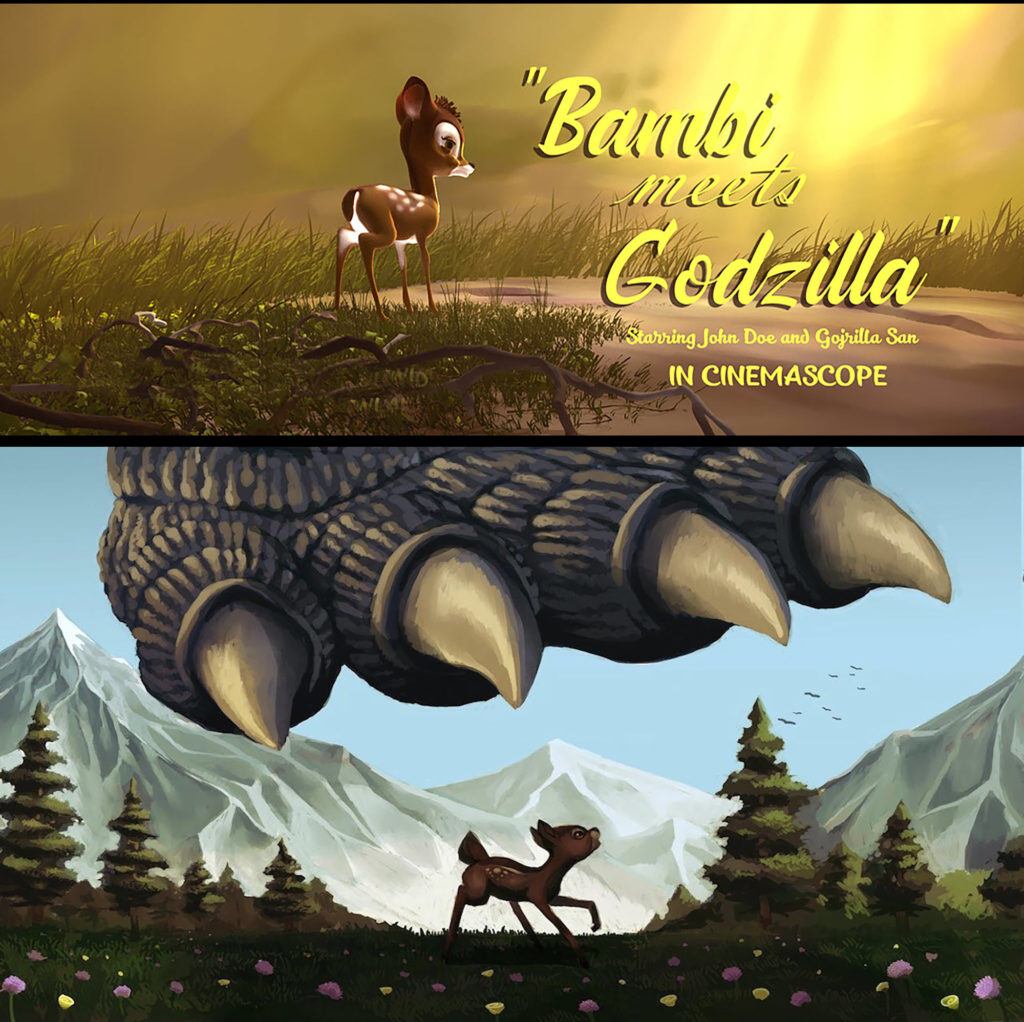
During the 1960’s and 70’s, the humor in our culture became more and more polarized. The most influential American publication of counter-culture humor was Mad Magazine. Mad was a wildly satirical reflection of the cultural landscape of its time. It was at its peak of influence during my formative years in elementary, junior high, and high school. It was a consumer heyday where media image had become more important than real life and commercial advertising began to be questioned by many such as Marshal McLuhan (the medium is the message) and Rachael Carson (when DDT became a commercial rage). Mad was thought of as trash by the establishment, an enemy to parents and teachers. My skeptical generation knew that there was something wrong, phony and funny about a world of nuclear bomb shelters, healthy cigarettes and toothpaste smiles; to us, Mad Magazine was magical, objective proof that we weren’t alone. When Mad started In the mid-fifties, such consciousness was nowhere else to be found. Donald Duck begins wondering why he has only three fingers and has to wear white gloves all the time and ends up wanting to murder every other Disney character. For kids who questioned the hypocrisy of the times, Mad was a revelation. It told us our teachers were phonies, our leaders were fools, our religious counselors were hypocrites, and even our parents were lying to us about nearly everything. It lampooned celebrities, free-formed satire on everyday life, politics, popular culture and even its own counter-culture with its Mascot, Alfred E. Newman and his nihilistic motto “What, me worry?”. I saved my money and bought every issue that came out. I can still remember a Mad Magazine poster that caught my imagination with a camel urinating in the moonlight with the caption “all that glitters is not gold”. As with many visual puns, this one questioned the literal and the status quo. Mad Magazine’s impact on humor for generations to come is incalculable. The Carol Burnett Show evolved further into Saturday Night Live; Laugh In went further yet with Monty Python; then came The Simpsons, R. Crumb, Weird Al Yankovic, Borat, and entertainers like Jerry Seinfeld and Steve Carell. Mad sensibility can also be seen in the weird Snoopy-like characters of South Park.
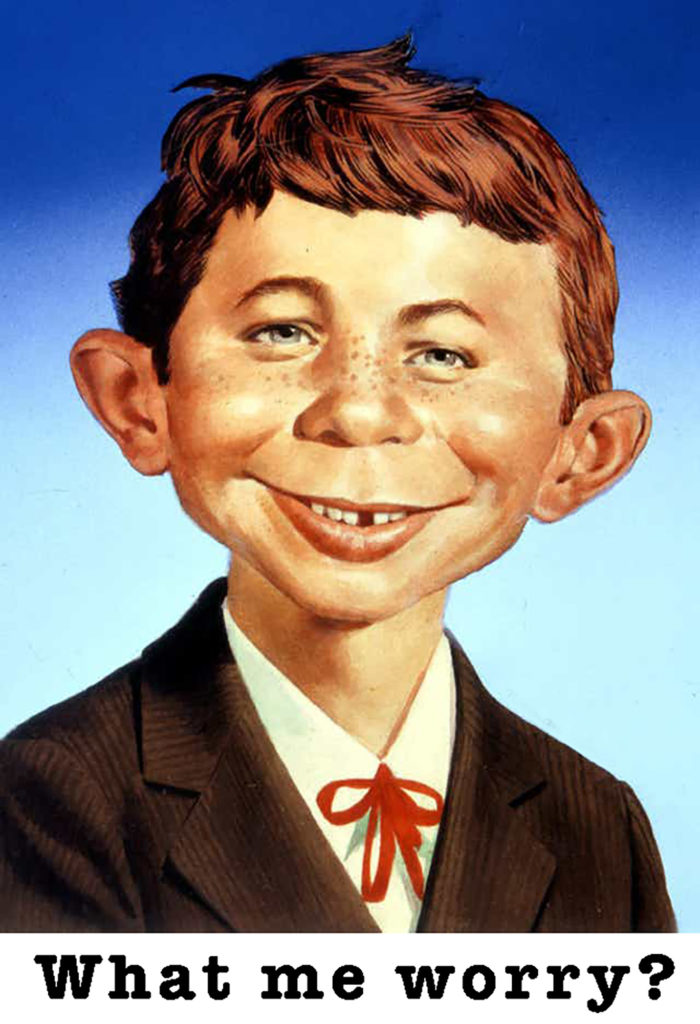

This 1975 Monty Python clip from The Holy Grail sums up this new humor towards “cute” as the sixties plunged into the seventies.
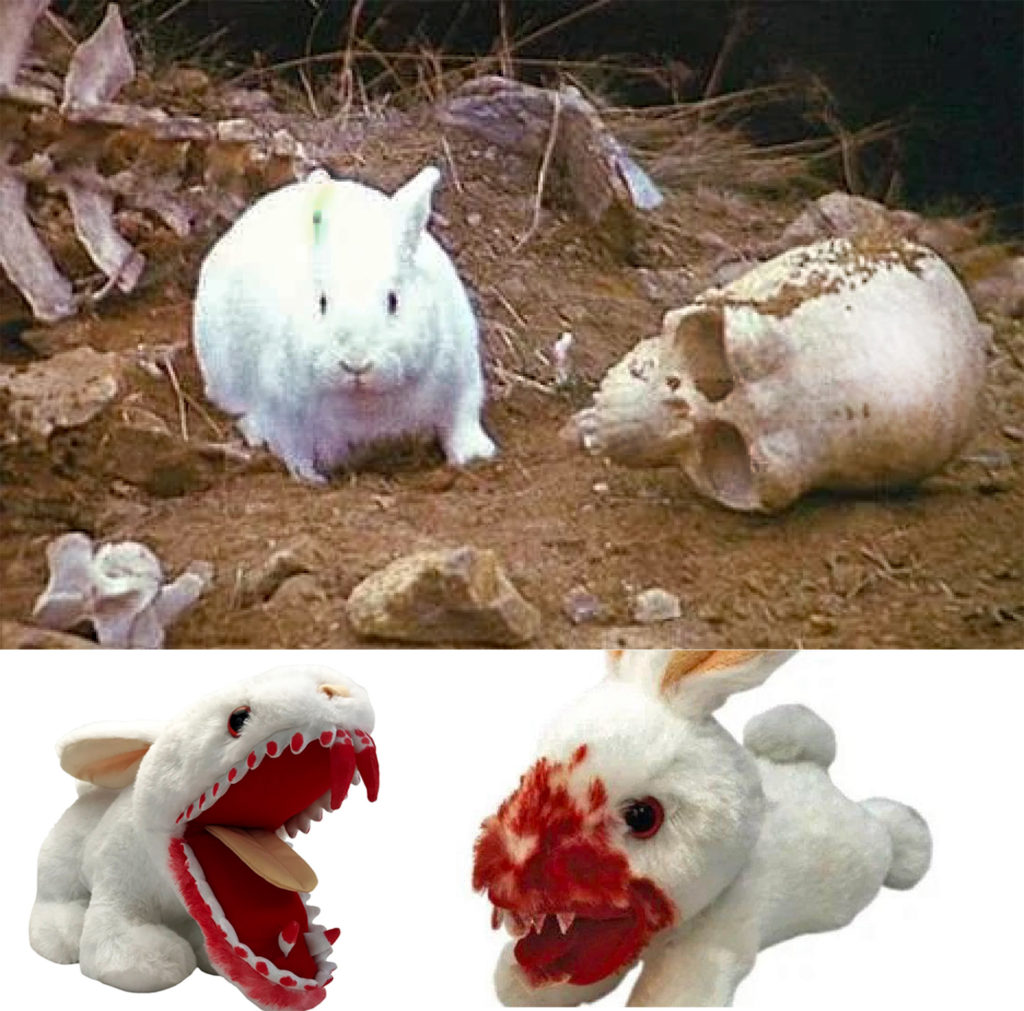
Yet even the humor I grew up with did not prepare me for the popular humor of today with the new “reality comedy humor” of Jackass. Its popularity yielded five movie successes, three full seasons on MTV, and after twenty years, Jackass Forever was a top nomination for the Oscars this year. I find not a single thing about Jackass humorous. When my seven-year-old son chose to see a Jackass movie for his birthday with a friend, little was I prepared for what I would experience. In one scene, a guy was locked up in an underwater suit with an old fashioned bubble headpiece. The others ate large quantities of beans, waited till they were ripe, then continuously farted into the trapped guy’s air pipe. The trapped guy gasped, choked and started puking until he almost died in his own vomit before he was freed. My son and his friend were howling so hard, they fell off their seats and were convulsing on the theatre floor in uncontrollable, screaming belly-laughter. I had to leave and wait in the lobby rather than sit through any more. I missed one guy pogo-sticking on his buddies crotch and sixteen miscellaneous brain concussions, including a brain hemorrhage after a direct hit by a raging bull. Much to talk to the kids about on the ride home there was.
It seems to be a male adolescent friendship thing where the rules are flipped upside down and after you share in the horror, you can go back to your normal life. There is no way any of it will turn out well, that is known from the get-go, and it is willingly entered into. The self-indulged victim is a martyr in his own act of total senseless juvenile idiocy; there is no message, no thought and no adult ideas about the world for anyone to have to deal with. It is also a kind of humor that you need to be part of an audience to socially share in the wincing, groaning, screaming, and whining. Judging by its commercial success, it fulfills some kind of sad need in our society.
Then again, when I think about it, I did envy a friend who could swallow air and burp the entire Pledge of Allegiance to the Flag and during Boy Scout campouts, when we cooked dinner over the campfire, we would eat as many cans of baked beans as we could. We waited till night to gather in a dark tent and watch each other light the combustible gas as it came out; we would delight in seeing torch-like flames of fire come out of our buttes. The bigger the flame, the more drama and the more danger of getting burned.
Perhaps that was a form of entertainment for early homo sapiens as well, when they gathered around their campfire in the evening after a hard day’s work of hunting and gathering. And then again, I did love the “Odorama” movie Polyester, by John Waters starring Divine. In this movie, each person in the audience is given a numbered “Scratch-n-Sniff” card and at certain intervals a number is flashed on the screen and you had to scratch the corresponding number on your card and sniff it. The “rose” was bad enough but when Divine farted and the number flashed, the audience let out a great moan before we all dutifully scratched and sniffed our cards. A study from Penn State University estimates that the human population releases about 73 metric tons of methane and 1000 metric tons of carbon dioxide into the Earth’s atmosphere daily by farting. That’s the perfect amount to guarantee the survival of our specie’s humor while at the same time not being enough of a global warming “footprint” to cause our extinction.
Here are some examples of a few humorists that my humor resonates with. The first two are well known American cartoonists John Callahan and Gary Larson, followed by Hugleikur Dagsson, a lesser known Icelander. Nordic humor can be quite dark as this cartoonist illustrates. It is also interesting to note that Callahan is handicapped and knowing this, somehow gives us psychological permission to laugh at his humor.
John Callahan
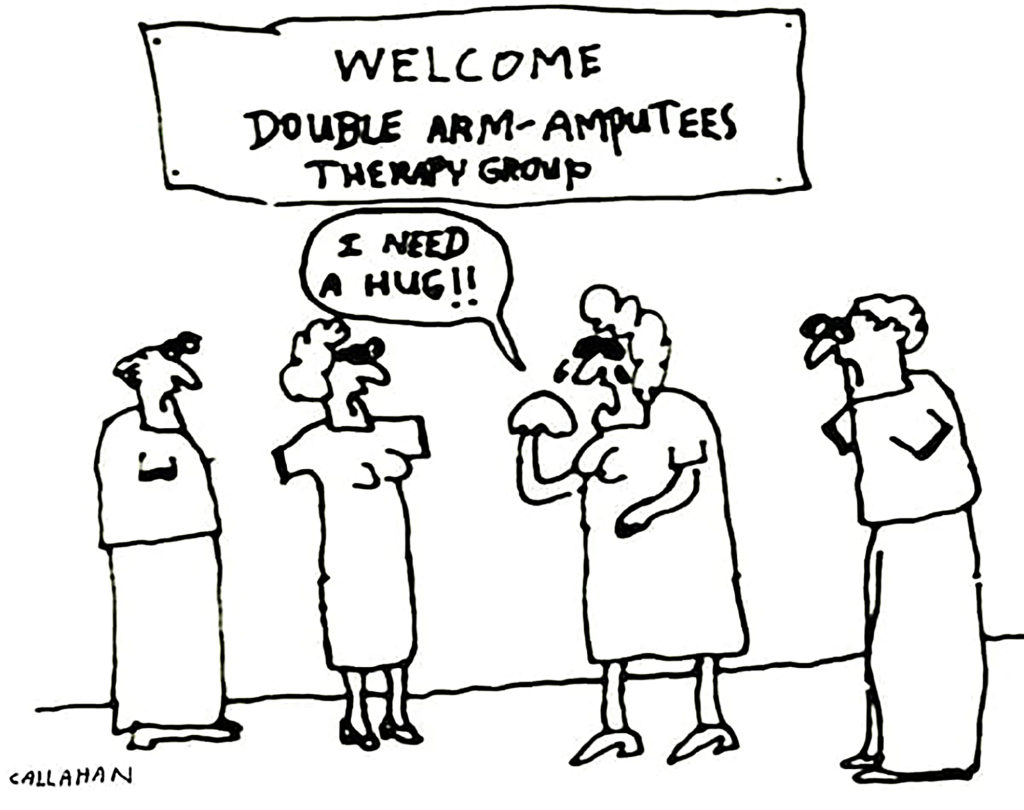
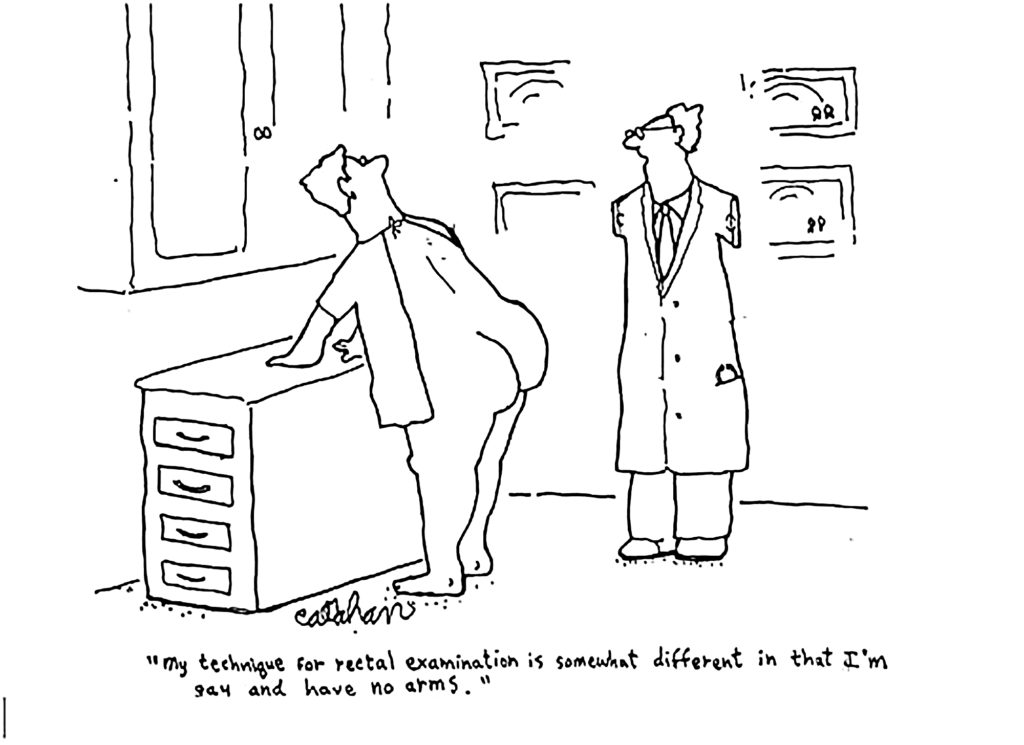

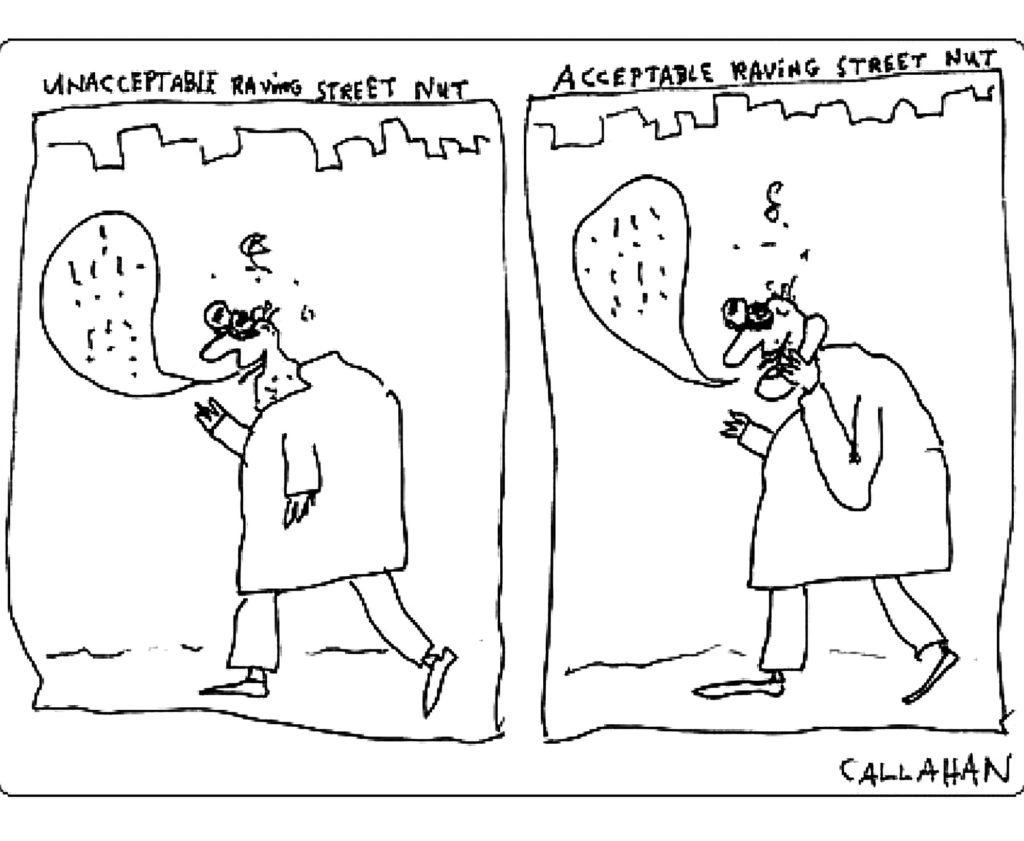
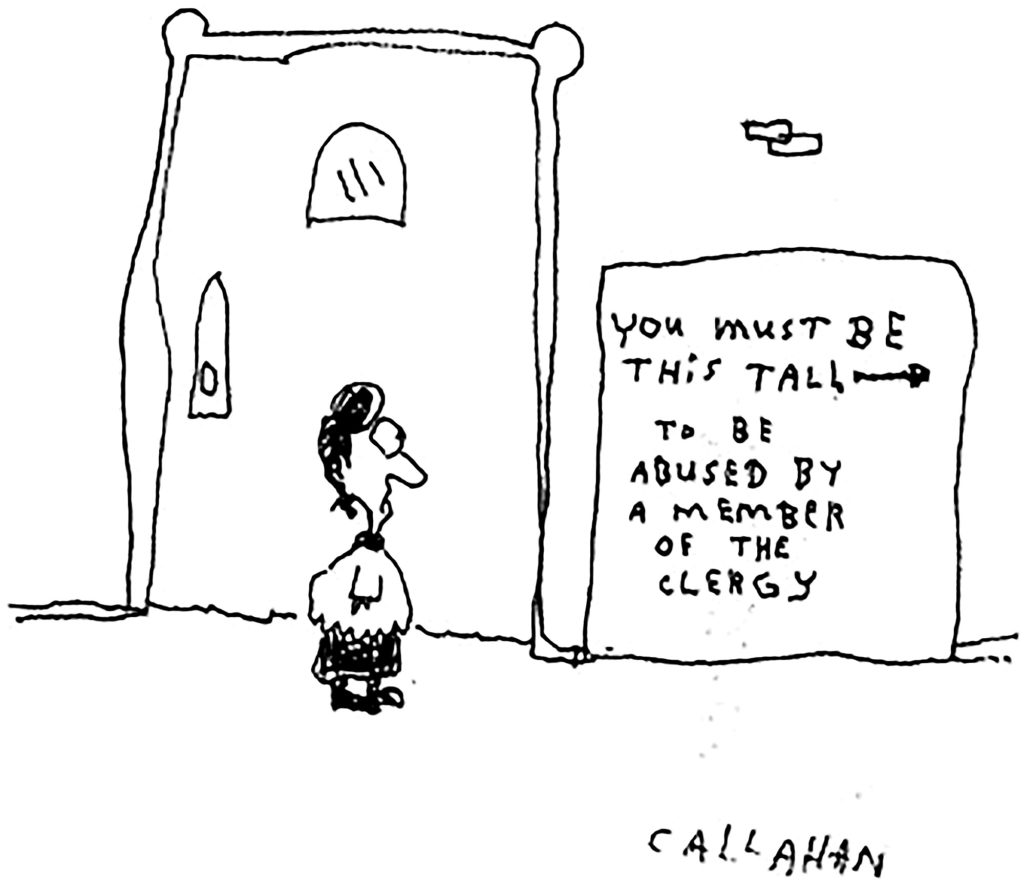
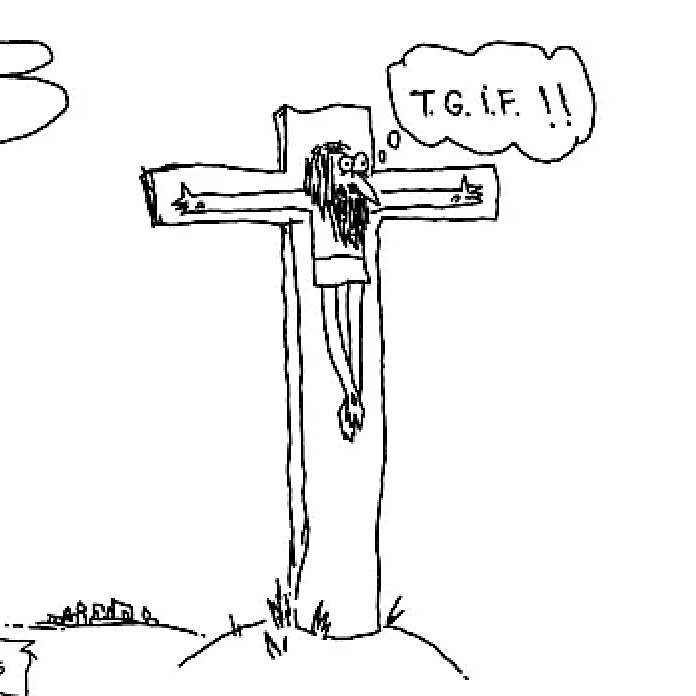
Gary Larson
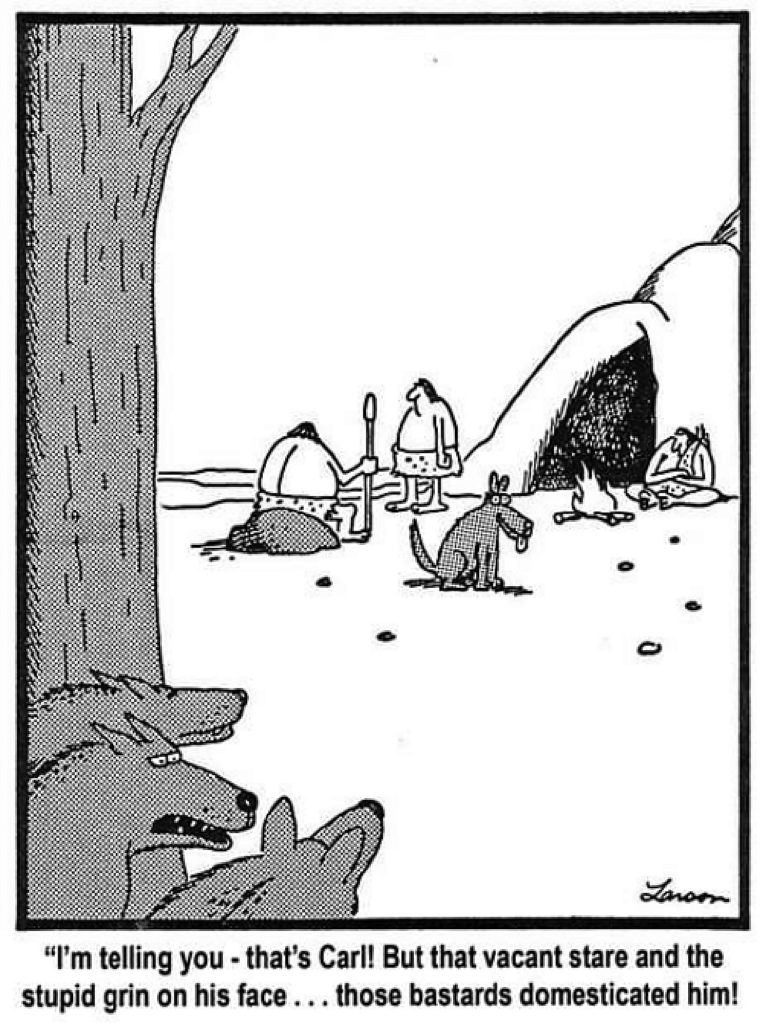
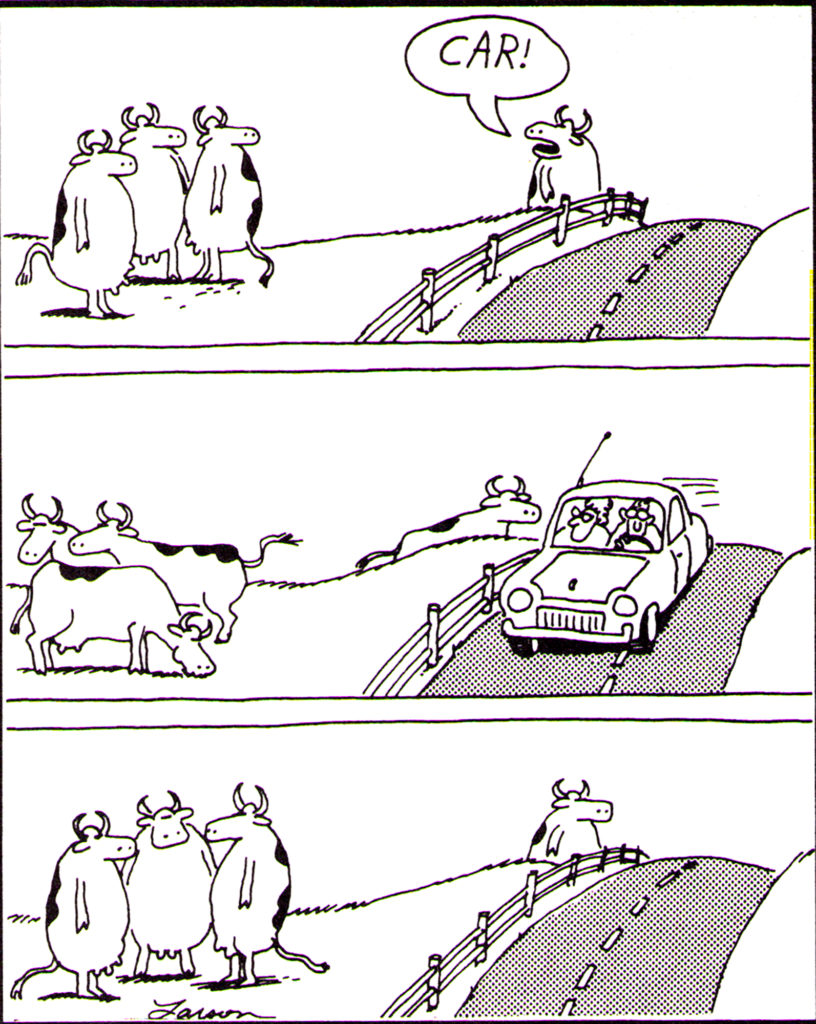
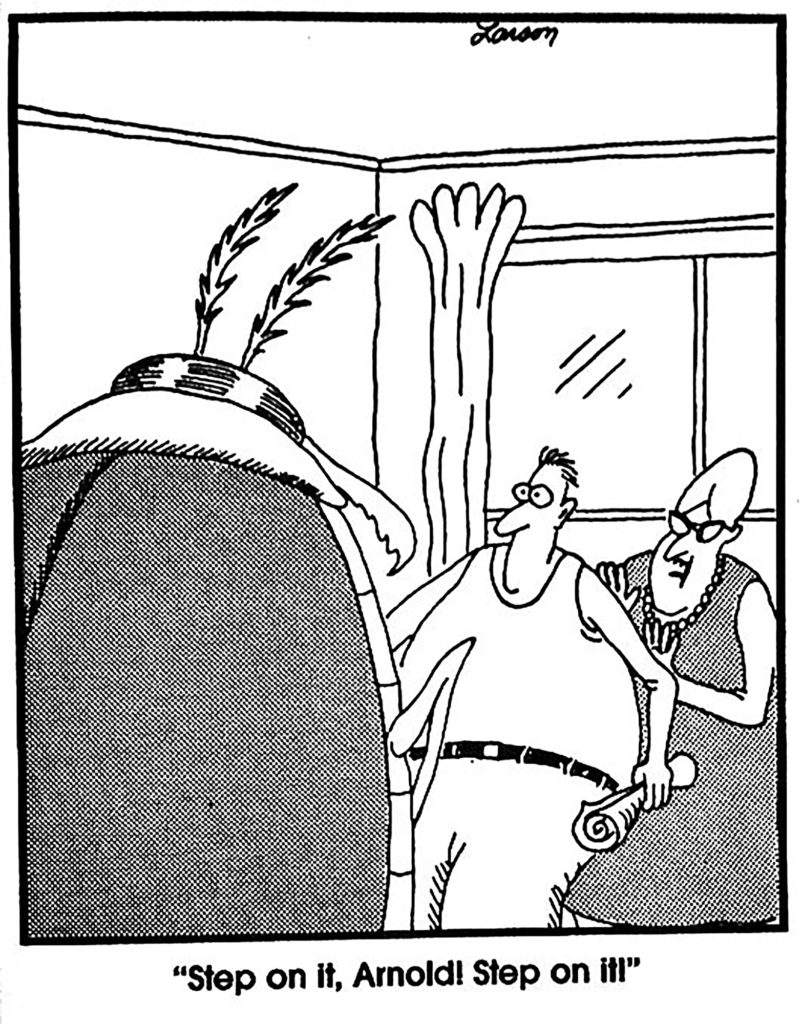
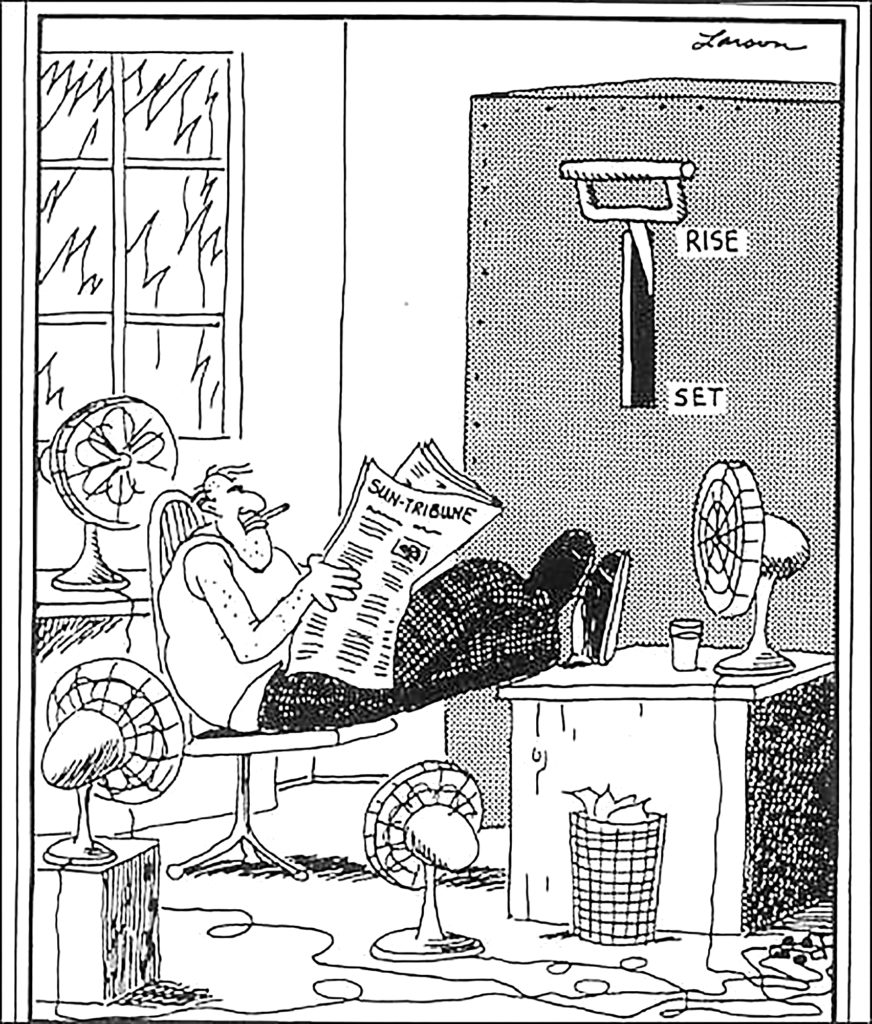
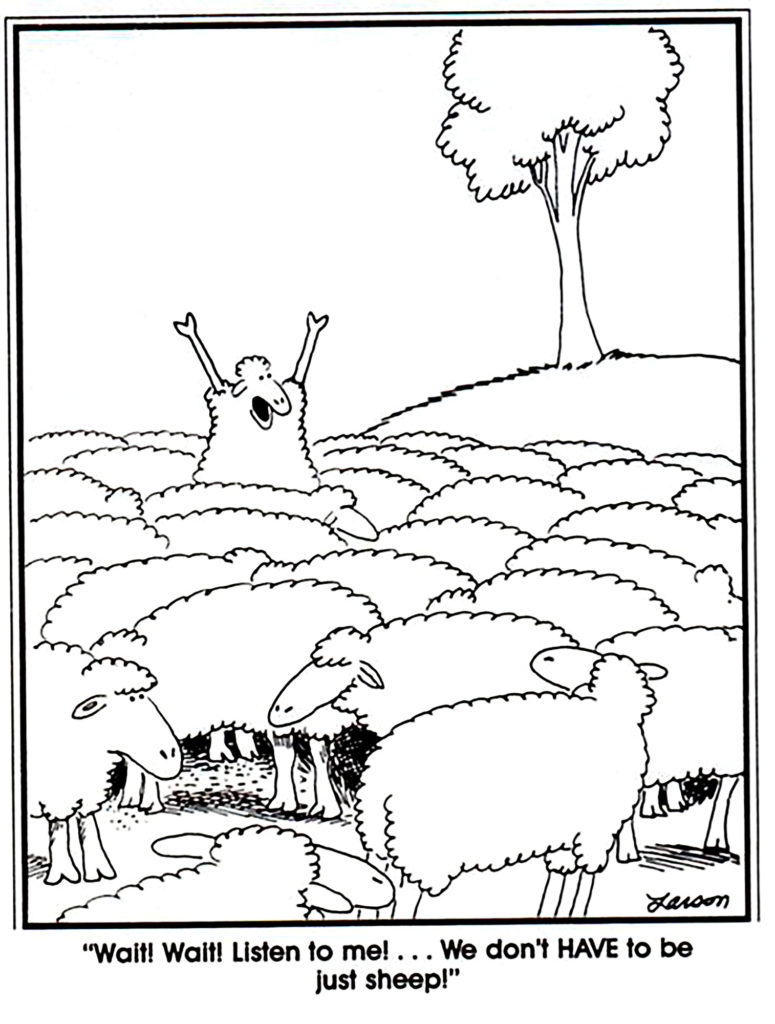


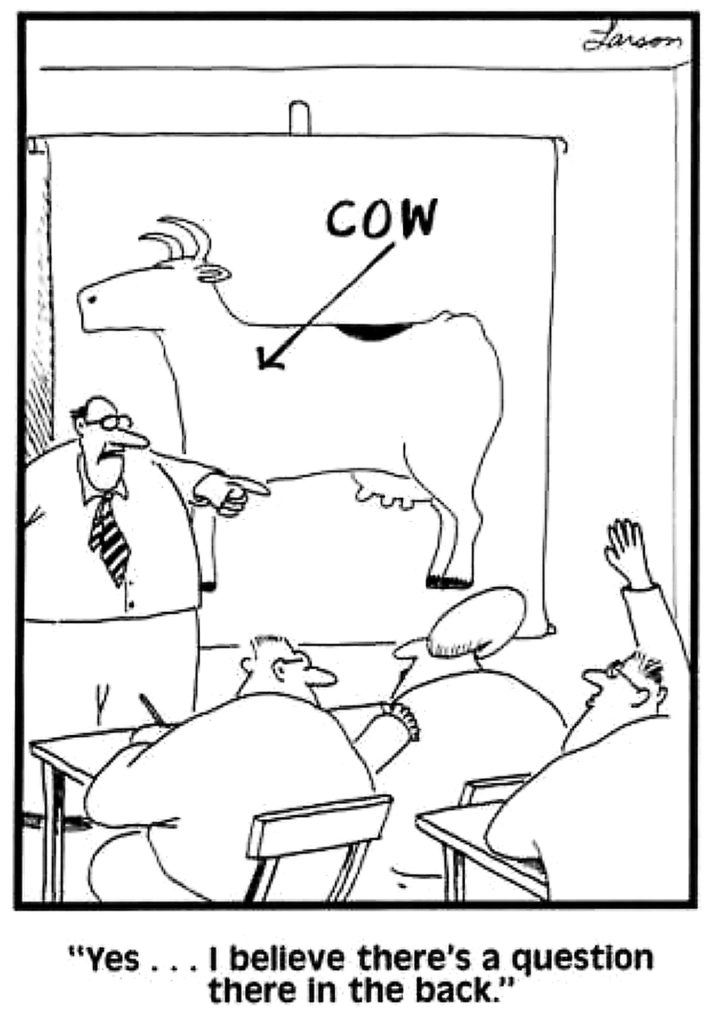
Hugleikur Dagsson
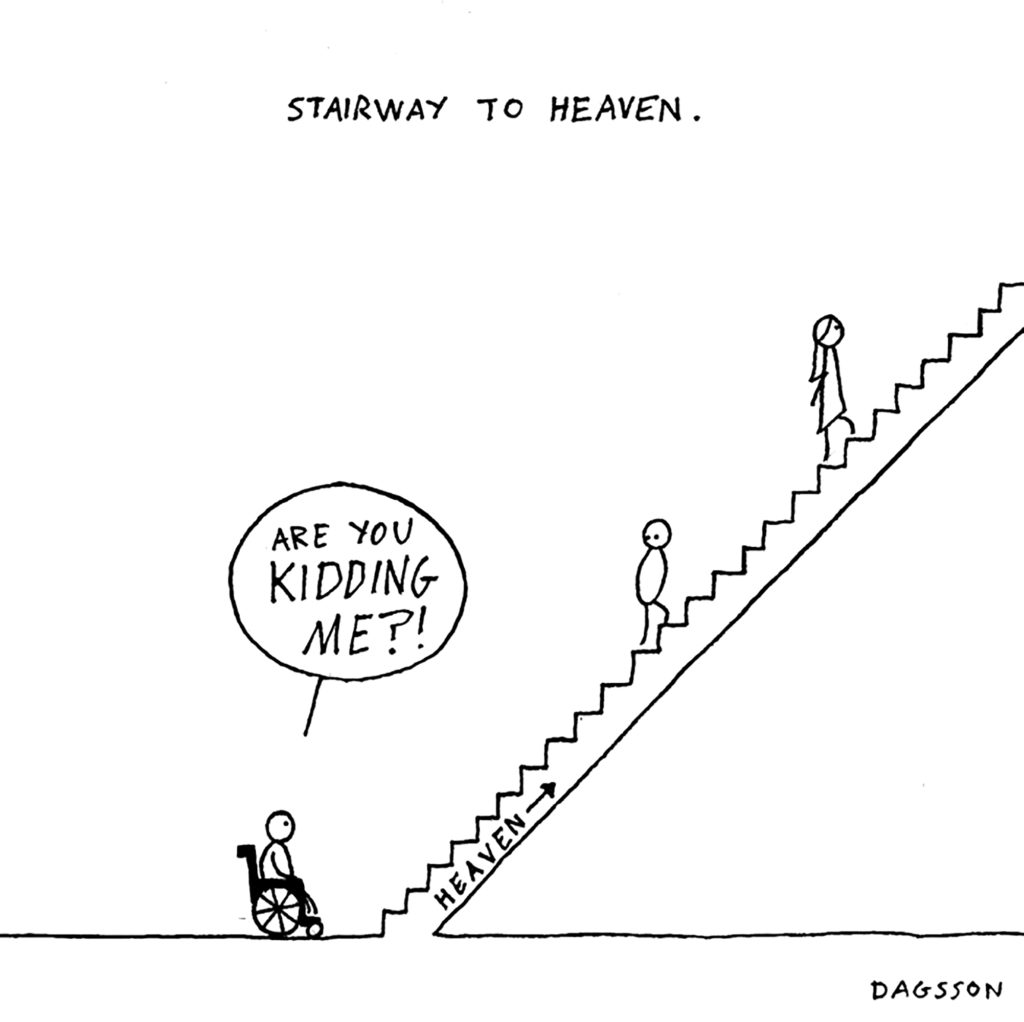
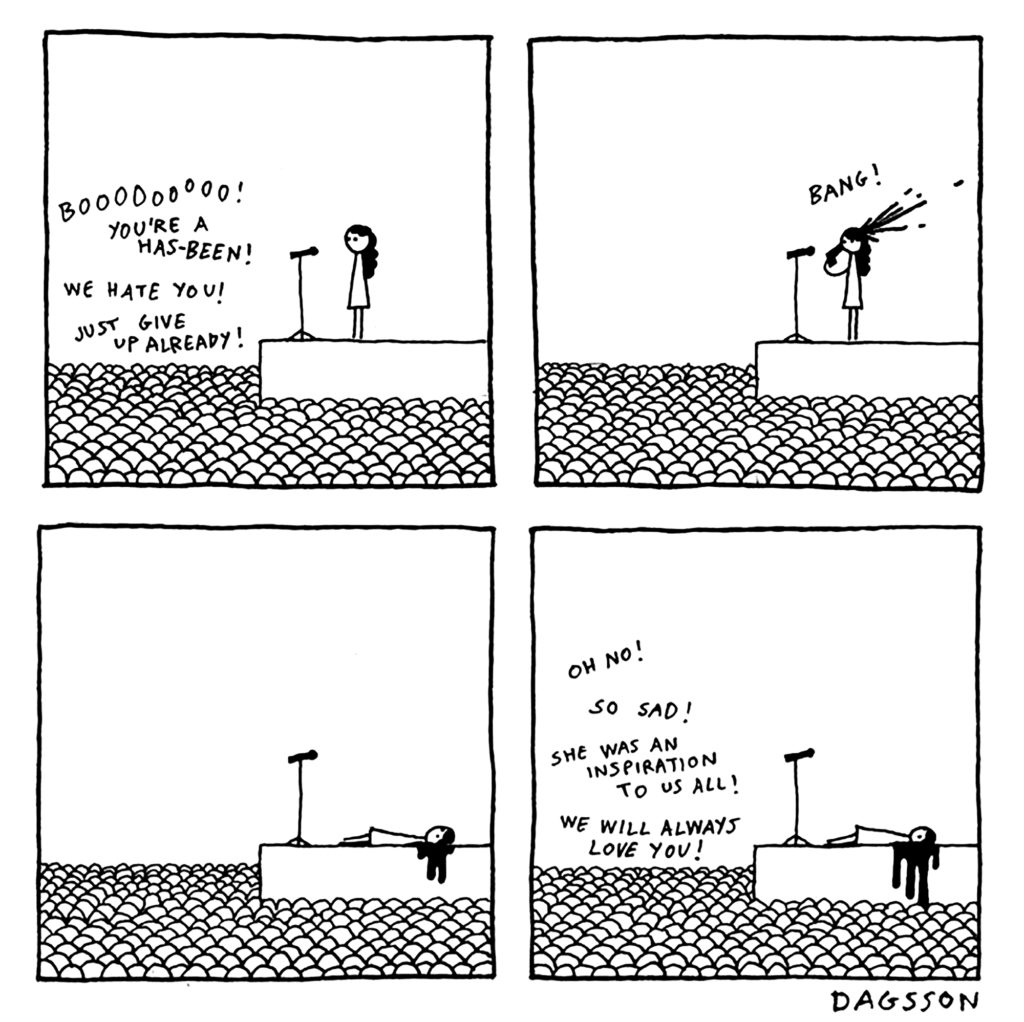
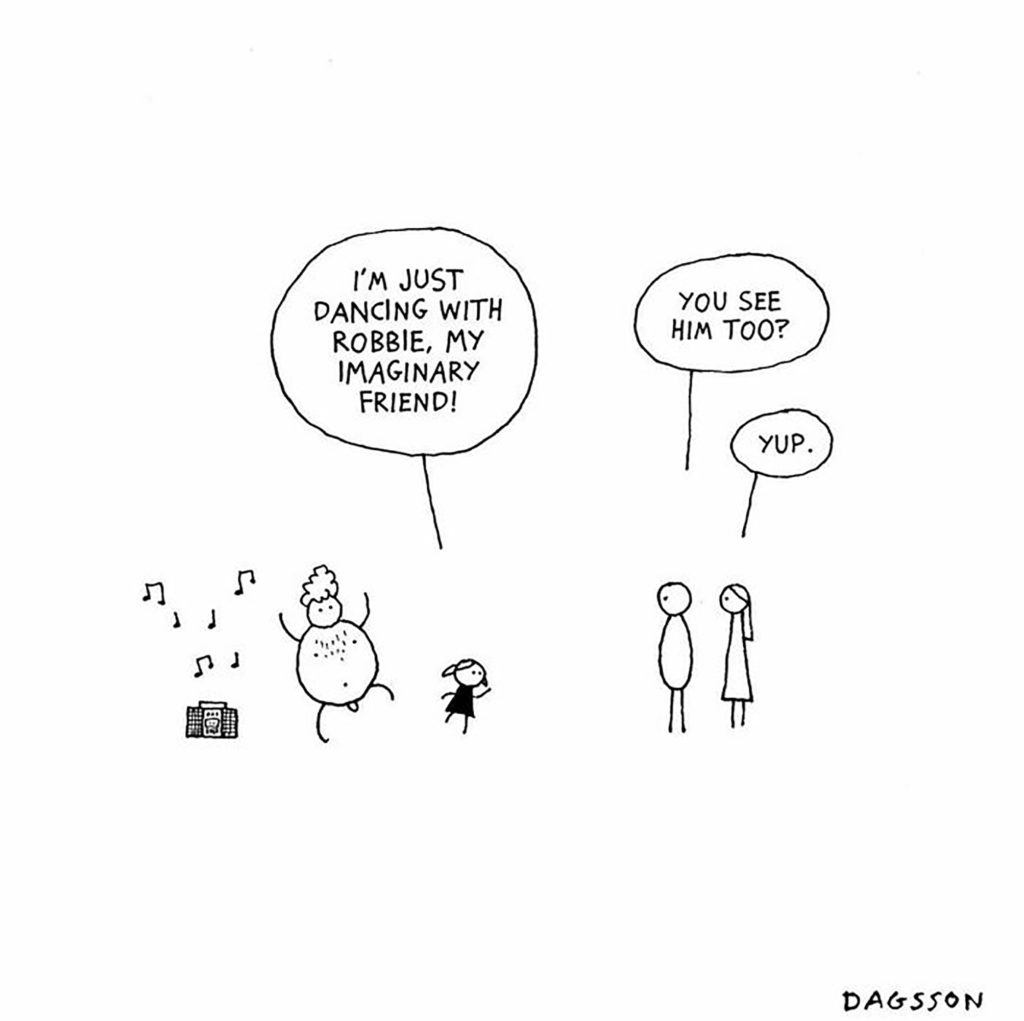
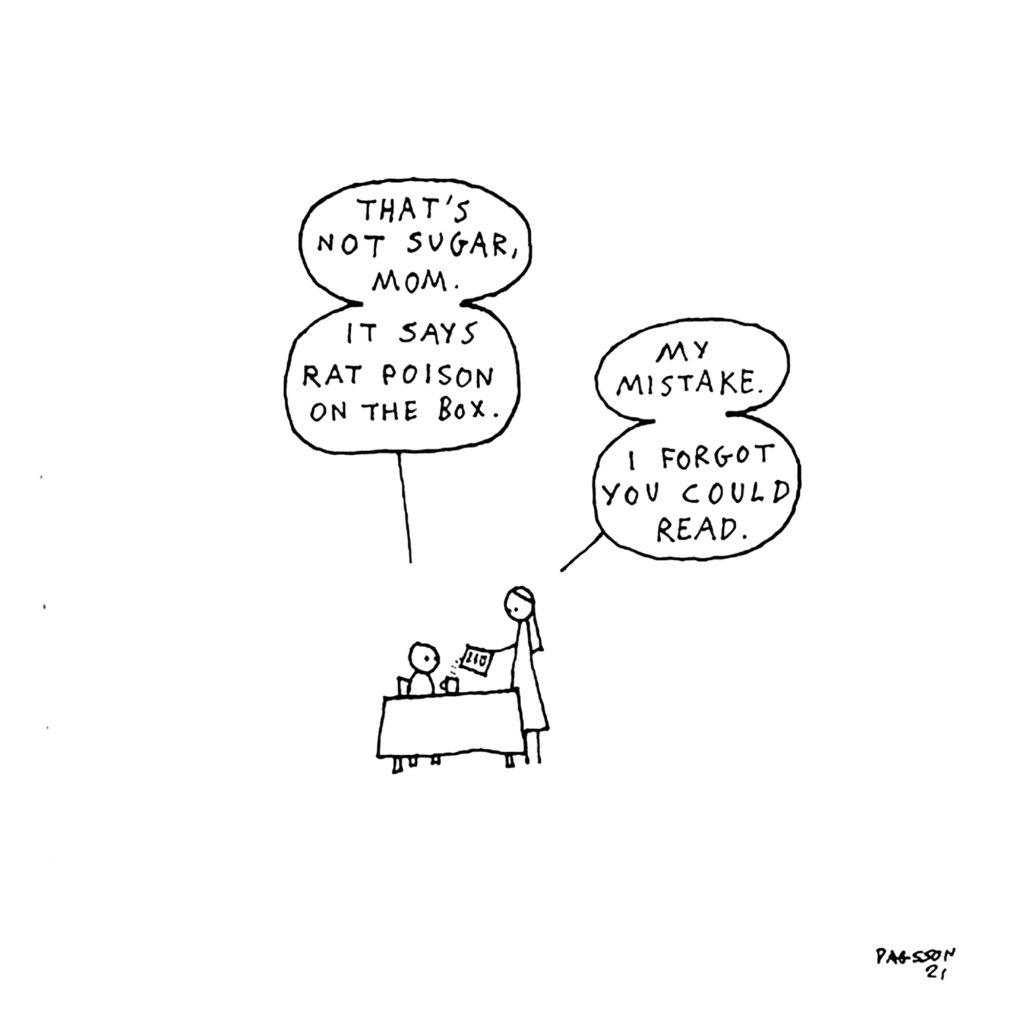






A couple new still lifes from my “All Things Peep” series
The humor in these still lifes has a wit and sensibility similar to the above cartoonists. Humor in my art is often tongue-in-cheek and is multi-layered with the humorous layer leading a viewer into other metaphoric content that is anything but humorous. In this sense, the humor functions as a perspective to approach life’s traumas.
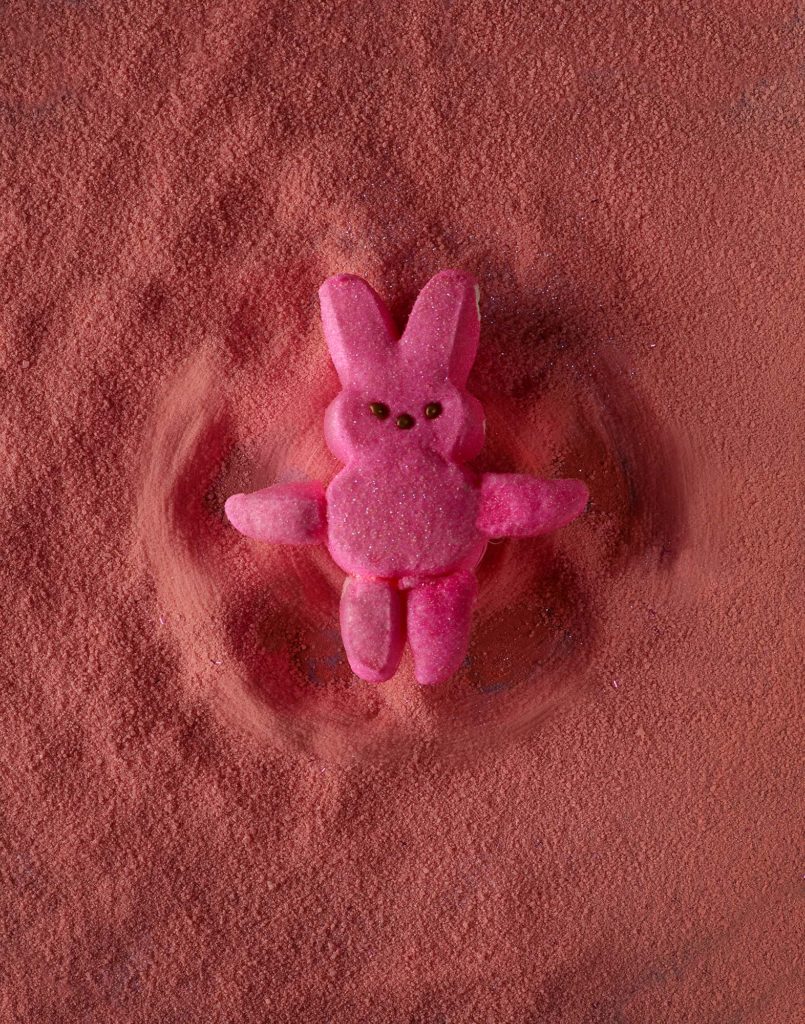
“The Joy of Appendages”

“Victor”
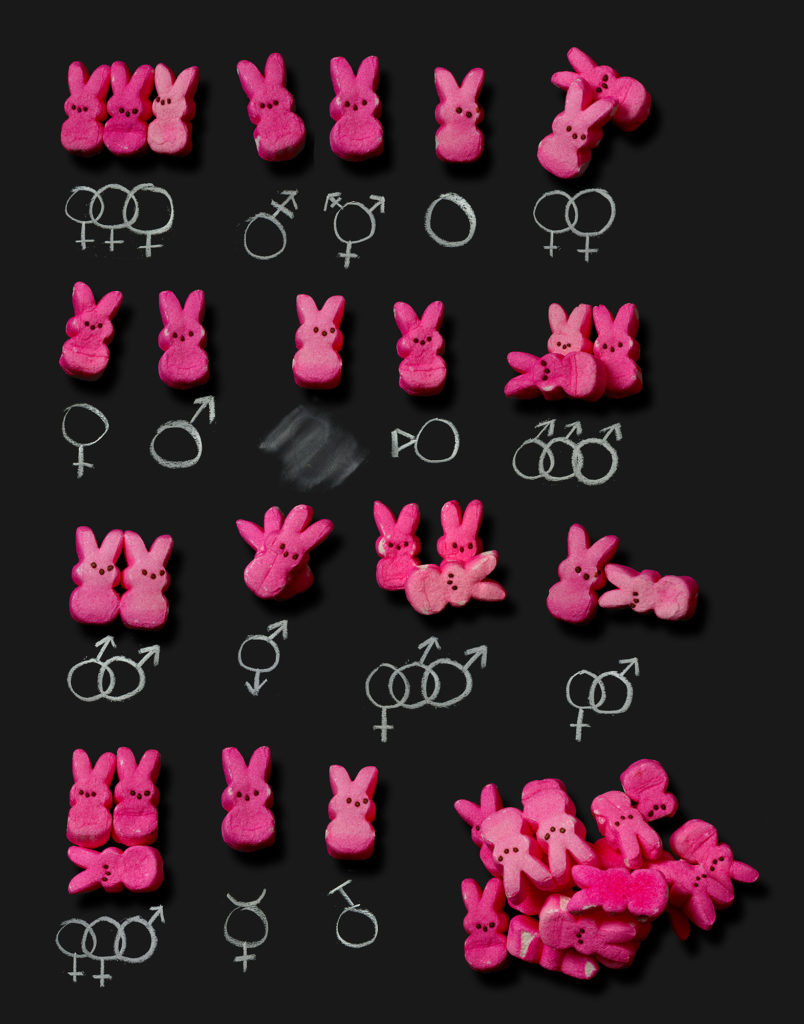
“Sexing Peeps” (lesbian, androgyne, transgender, asexual, gay, female, male, uncertain, third gender, gay, gay, gay, bisexual, heterosexual, bisexual, hermaphrodite, transvestite)
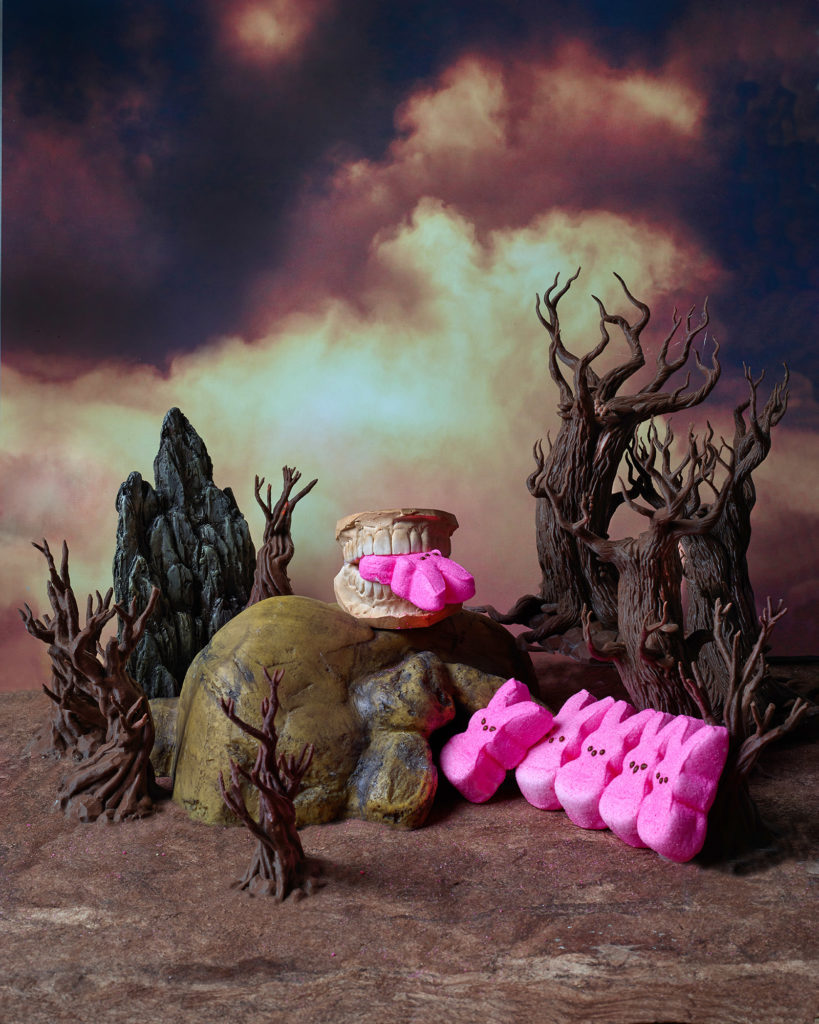
“Predator”
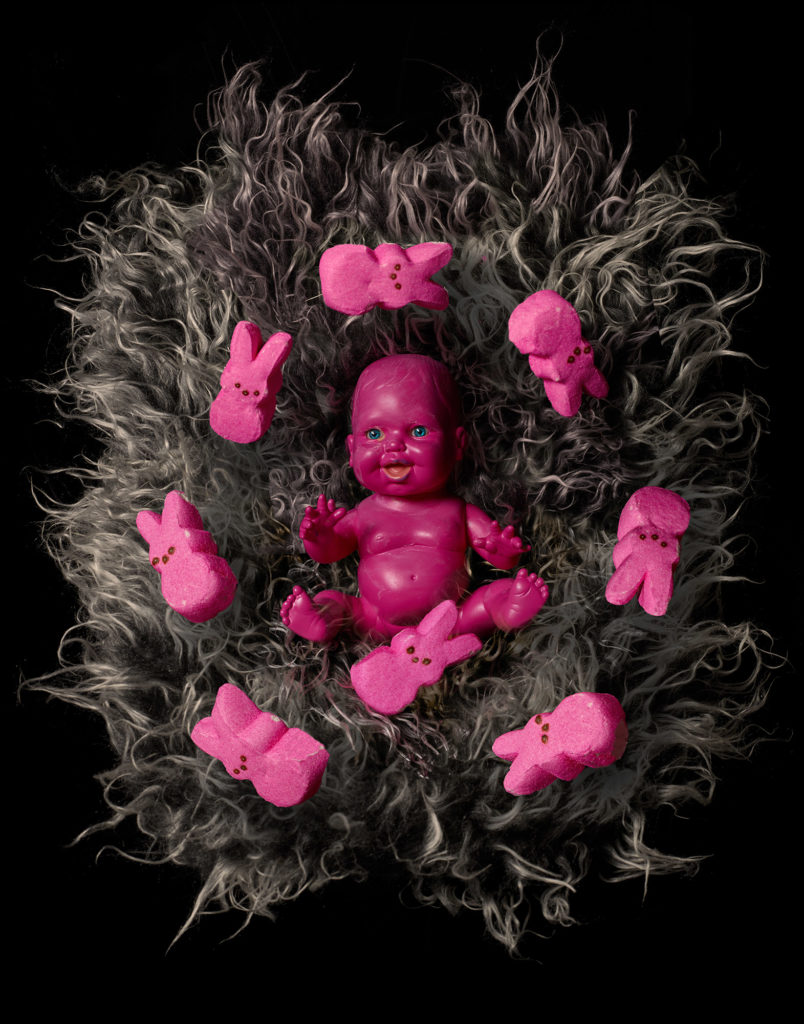
“A Child’s Joy”
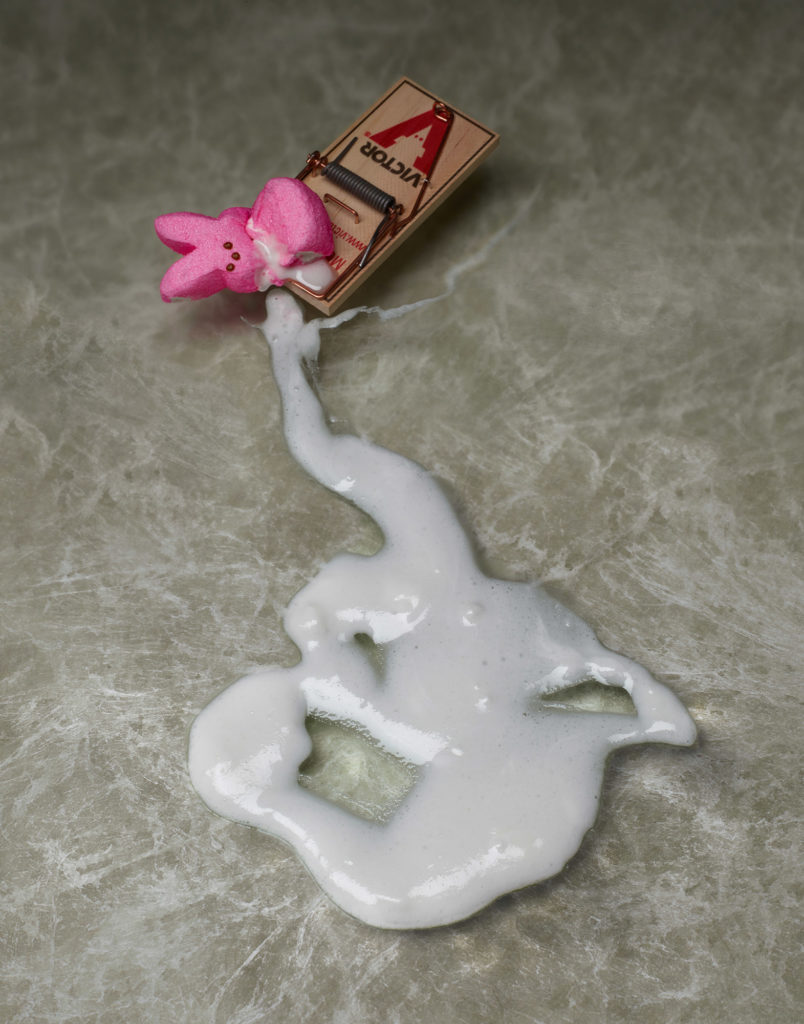
“Even Peeps Bleed”
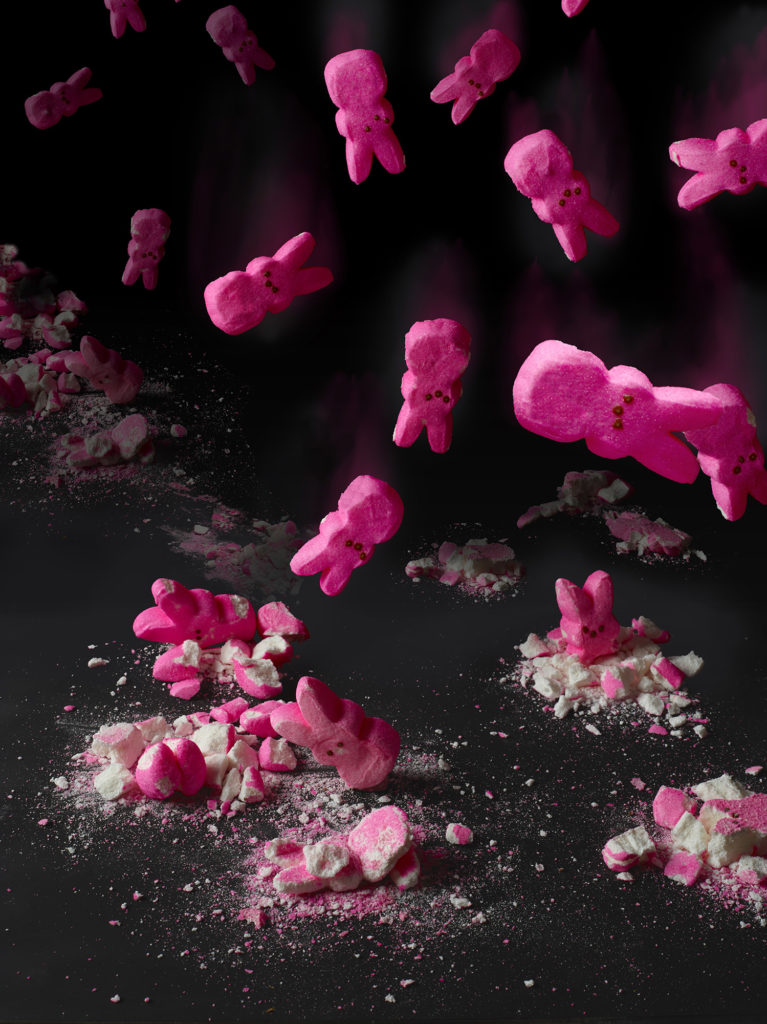
“Newton’s Third Law”
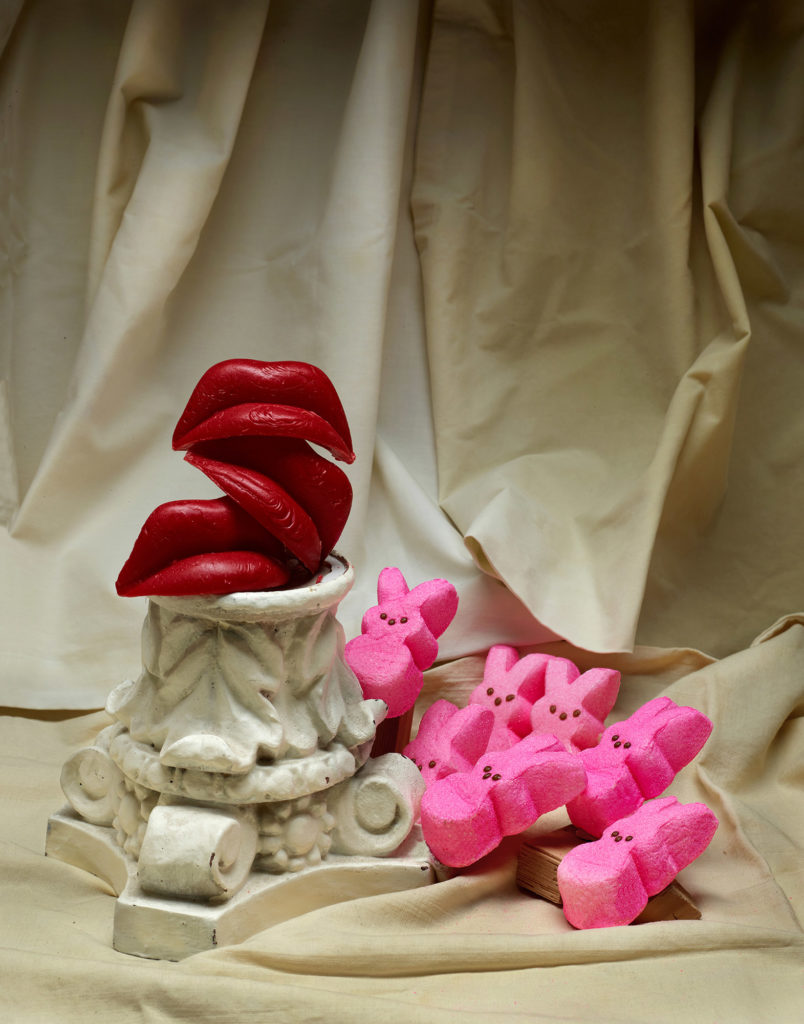
“Lip Envy”
3. Japanese English
Upon moving to Japan in the late 1980’s, my humor was both stimulated and challenged by living in a culture with vastly different ideas about “cute”. My repulsion towards the “cute” became dysfunctional in a different cultural context and in an attempt to understand, my distaste for the “cute” morphed into an attitude of fascination. One of my objectives in moving to Japan was to experience reality from a non-Western perspective. Japanese culture certainly provided that. I had always felt an affinity with Japanese manners, ways, aesthetics and thinking, which made me fertile ground for what I was about to experience.
Human understanding of our universe is language based from early development; we learn to think in language. The Japanese language was formed in isolation from Western languages and not only has different words but has a different grammar structure to organize thought that does not exist in Western languages. One of my vehicles for learning to think differently was to learn and to directly “think in” the Japanese language; in so doing bypassing the way that English language structures thought. The goal being to understand reality through a different lens by organizing experience differently. To a great degree I was able to achieve this goal and the result was that my time in Japan was one of the greatest growth periods in my life. I do not pretend to be an authority on anything that I write about Japan, just an observer who had access from the inside to a culture in which I survived and thrived.
On the surface, I saw contemporary Japanese culture as obsessed with all things American. Yet from an American perspective, none of it made any sense. The look was appropriated from the West, with the guts and meaning replaced by something having nothing to do with its Western roots. In other words, it no longer had anything to do with American culture, it only looked that way, it was Japanese. The appearance in Japan of something that seems familiar is always confusing to Westerners because things are never as they appear. I used to think that hiding under every classic Japanese kimono was a Mickey Mouse tee-shirt.
Context is everything for meaning. Interpreting the American meaning of something within a foreign culture usually does not work. I think of the outrage that a bikini-clad woman on a Coppertone billboard would cause in The Middle East or an ad in Myanmar in which Buddha wears earphones putting the advertisers in prison. Such idiosyncrasies that result in sales within one culture, result in prison terms in another or even worse when French humor in France resulted in a terrorist death sentence from another culture. The ability to understand things within different contexts and cultures is a difficult, if not impossible, challenge for most.
In Japan, the English language is often something of fashion that does not even function as language anymore. The Japanese don’t wear holes in their jeans, so paying a thousand dollars extra for the big holes is worth it for fashion, or wearing huge over-sized Christian crosses to look like Madonna vs. identifying as a Christian. My favorite “idiosyncratic absurdities” in Japan were all the “Japanese-English” that I ran across in the most unexpected places. Japanese products acquire an element of “cool” or “classiness” if they are decorated with English language, the sense or nonsense of meaning being irrelevant. In America we have a similar idea that Asian is exotic and kanji is cool. Perhaps that is why we see so many kanji tattoos in our culture. There is an air of elegance and mystery to a kanji tattoo and on the side, the person who wears it might even possess a secret knowledge of what it means.
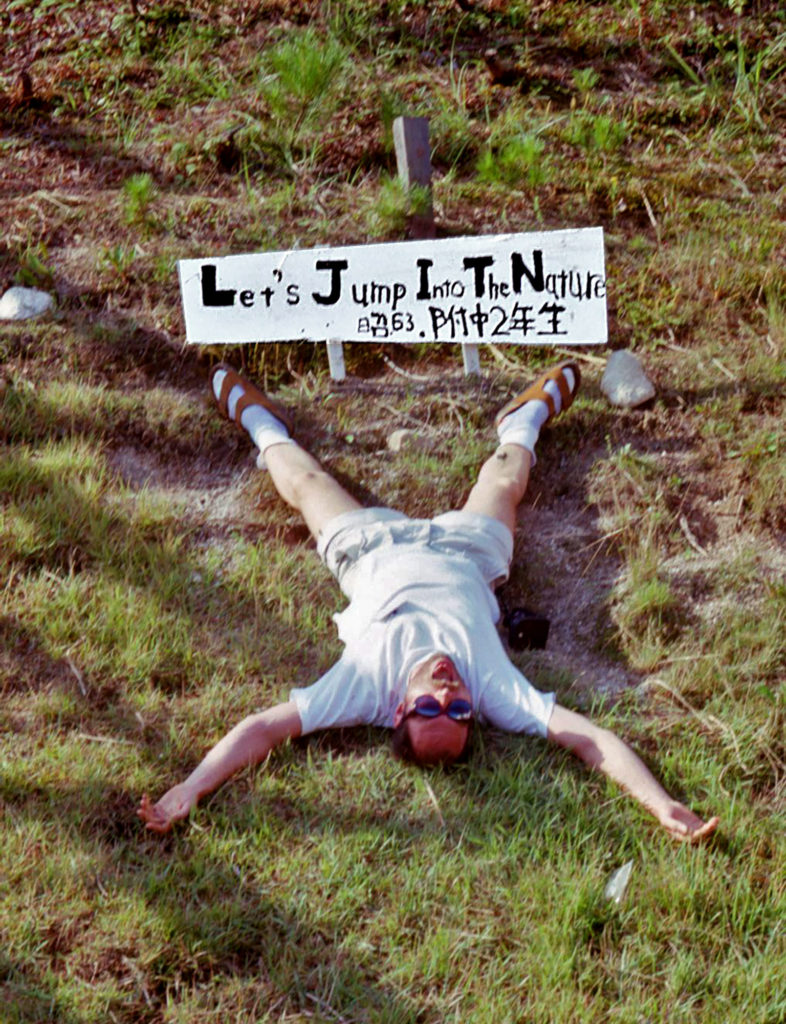
Hamming it up during a weekend at a “wilderness” resort. The expensive nature experience was “satisfaction guaranteed” so they had audio speakers hidden throughout the wooded cabins to play bird calls starting at sunrise. It had me fooled until I commented to a cabin mate how vibrant the bird life was here – then he pointed out the camouflaged speakers in the trees. Hikes were guided, just stay behind your group leader’s flag and don’t wander off the manicured pathway or you might get the fresh white shoe polish on your canvas sneakers dirty.
Two portraits from my Japanese portfolio with Japanese English in them:


A collection of Japanese-English
Japanese-English is often like a DaDa poem, where you pull random words out of a bag and when you put them together, they seem to make some kind of nonsensical sense or sensible nonsense.




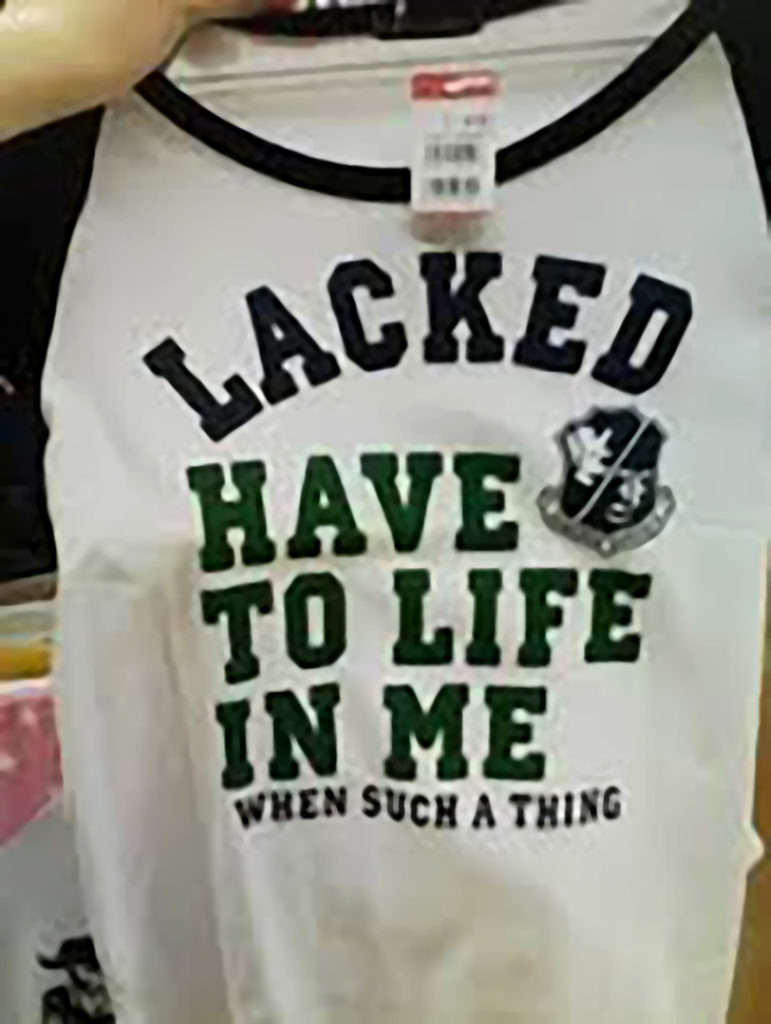


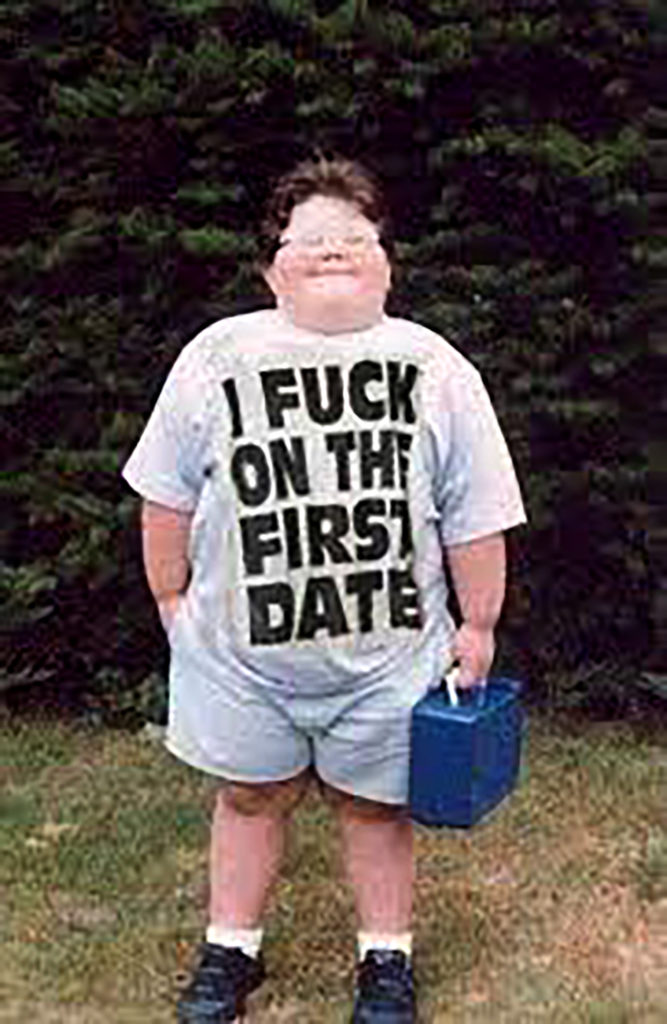
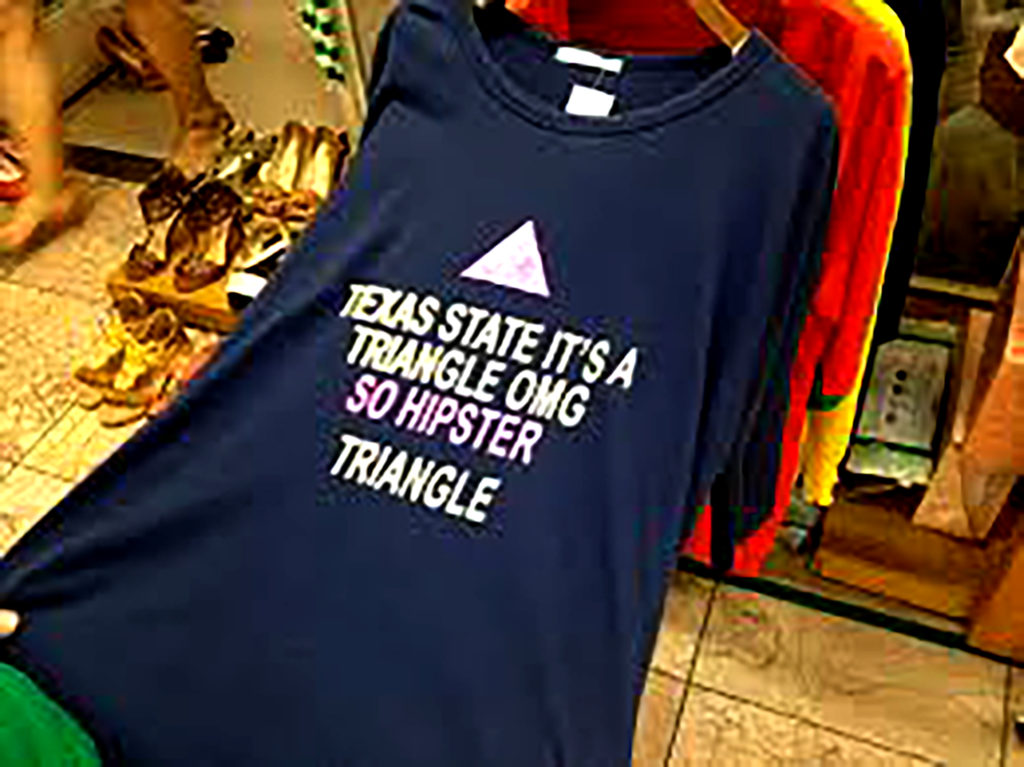
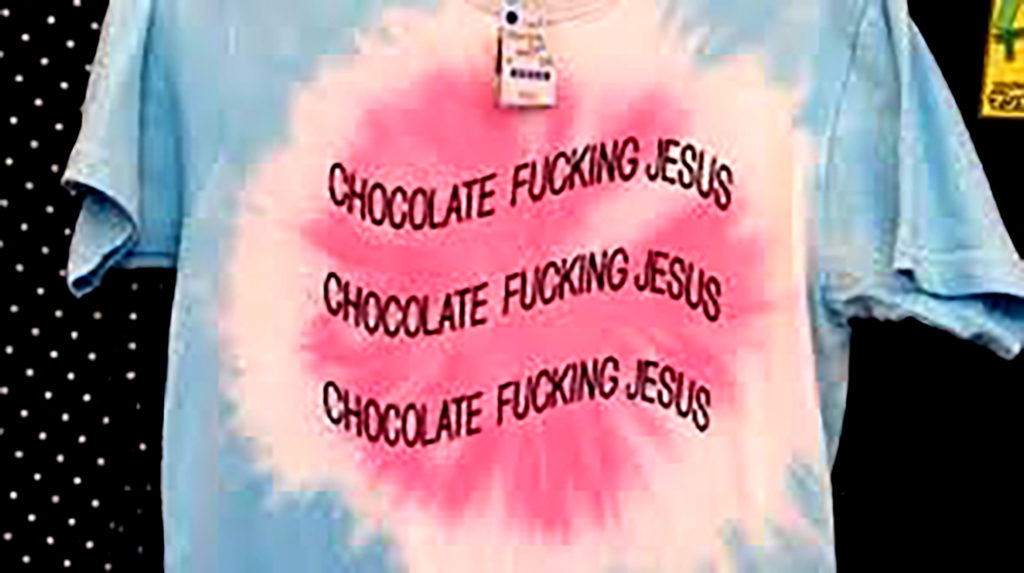
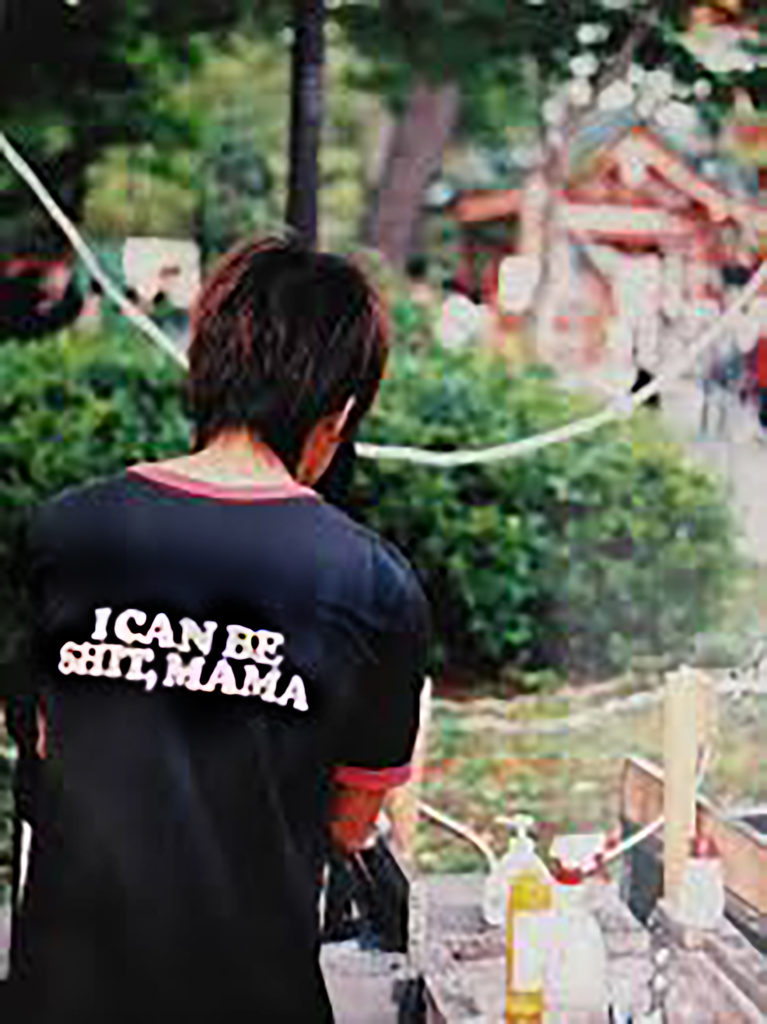

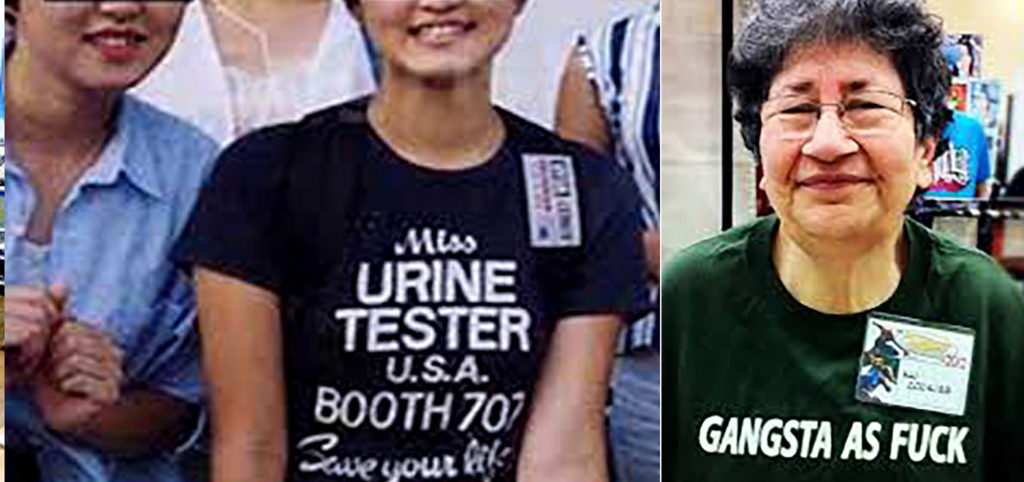

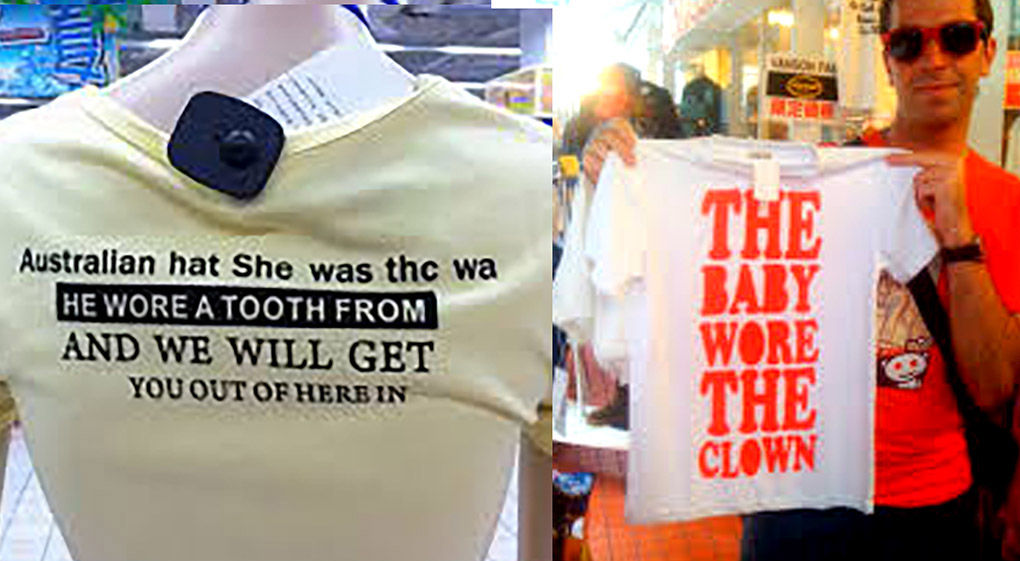


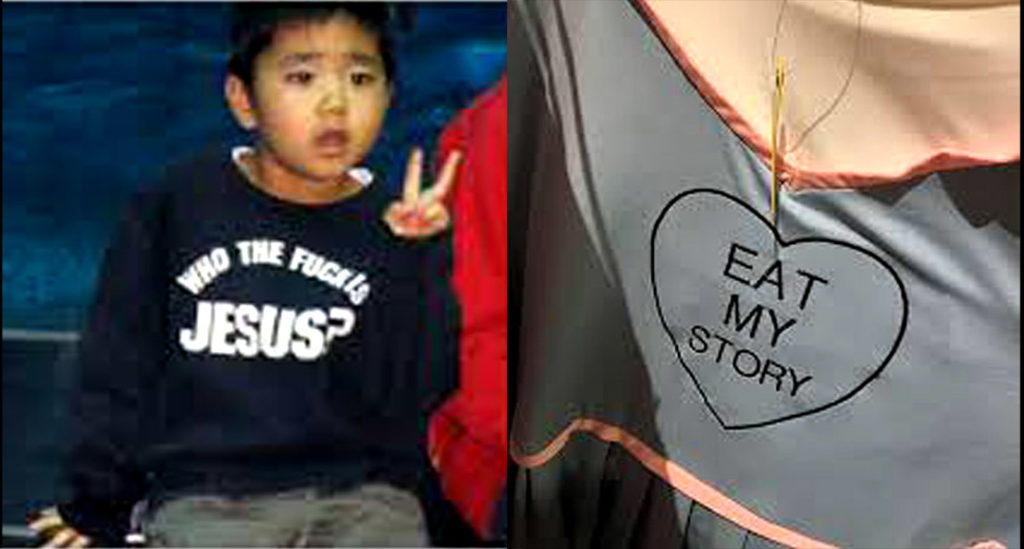


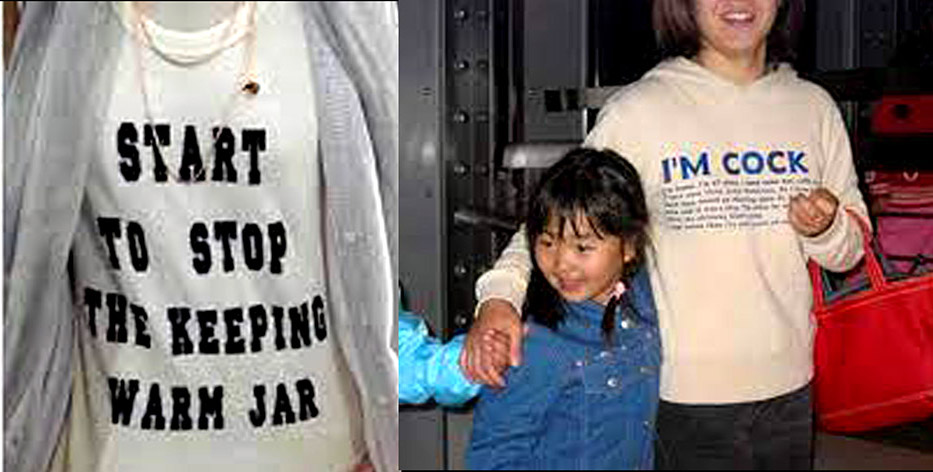

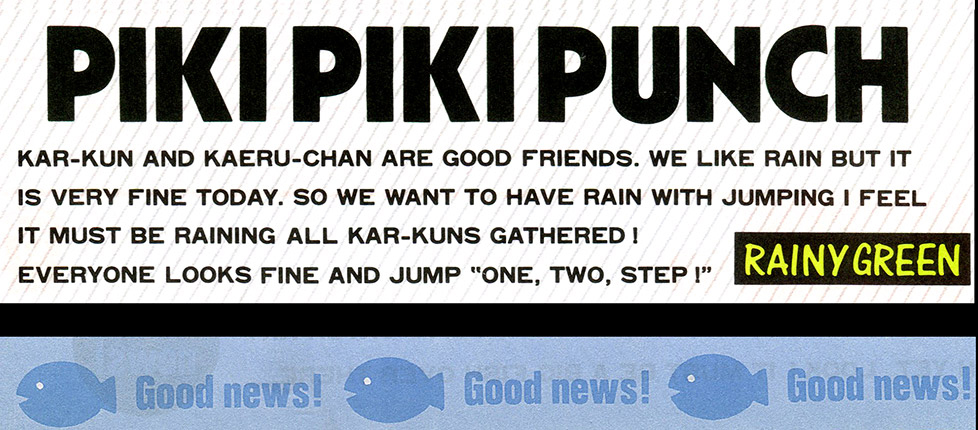
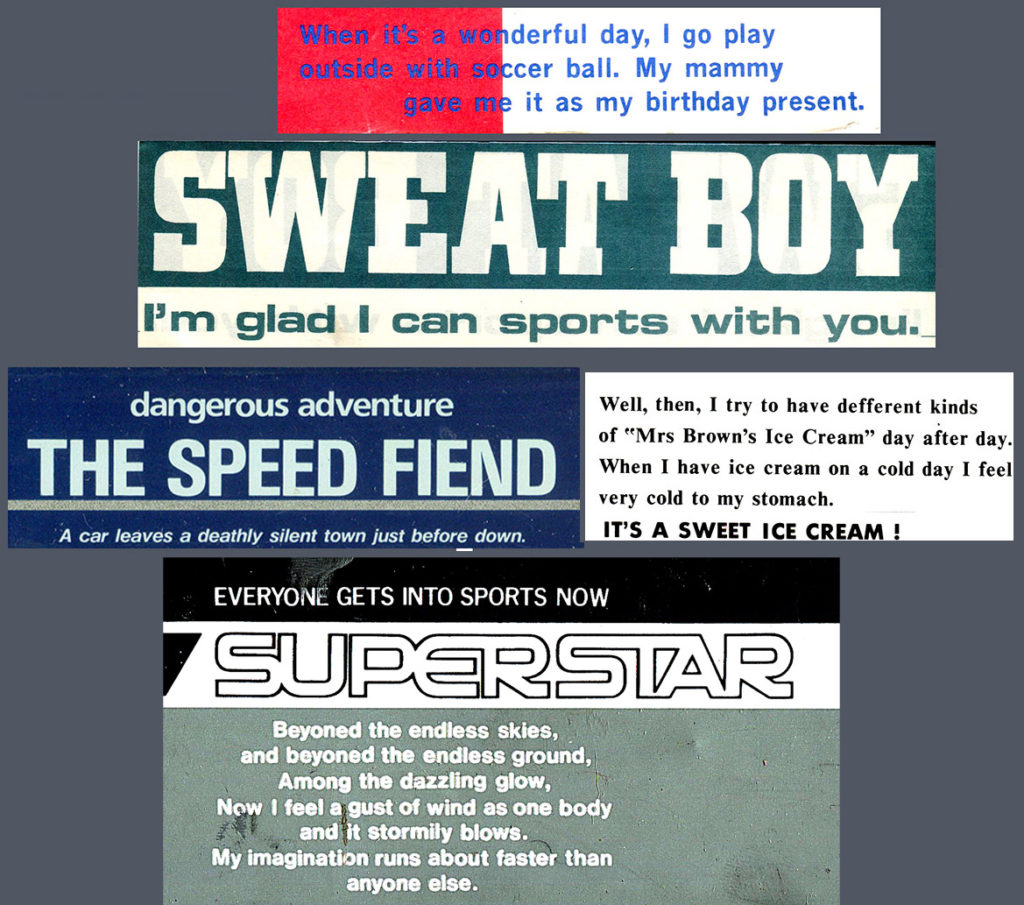
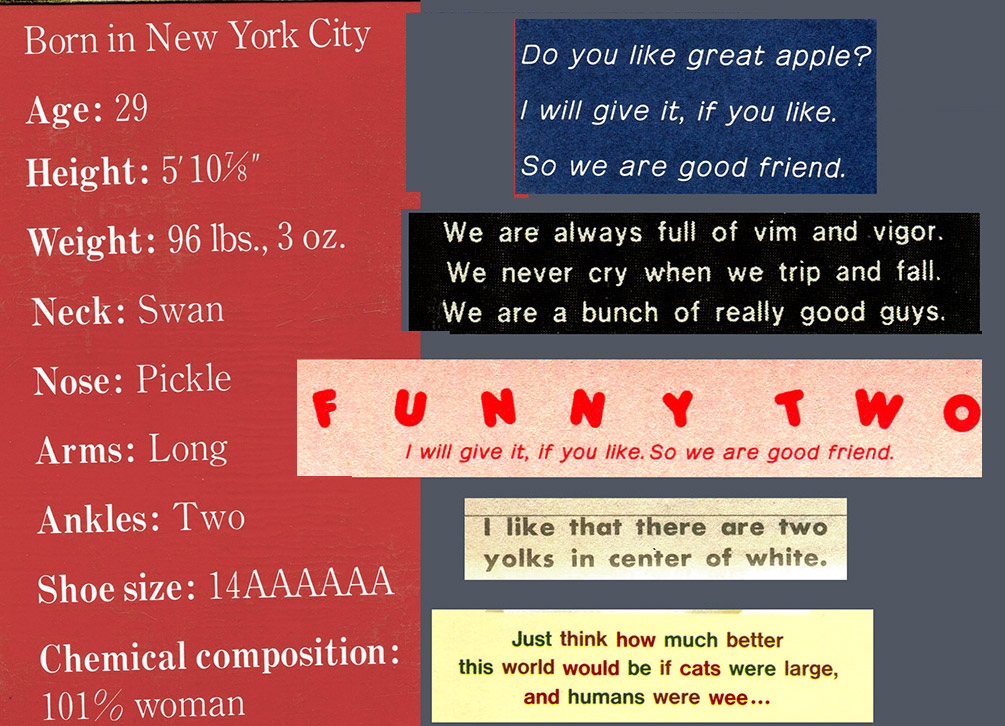
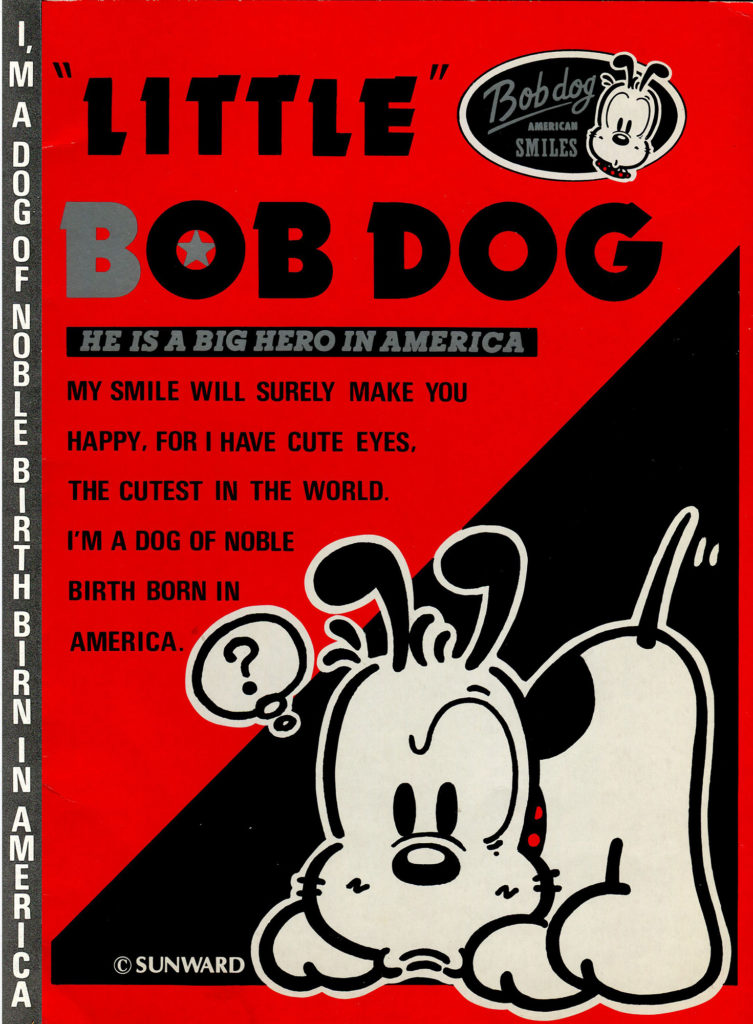


One especially challenging moment in which I was confronted with understanding the Japanese thinking behind an English phrase was in a junior high class that I was teaching in a remote mountain village. For most of the kids I was the first foreign person they had ever seen in real life, (one student told me that seeing me was like seeing an exotic Caucasian department store mannequin come to life). The usual routine in the school was at the start of each class, all the students would jump to attention next to their desks in military fashion, then abruptly shout out the word “Rei!” in unison and quickly sit down. This was supposed to denote respect and give subservient authority to the teacher, kinda like a military salute or a heil-Hitler arm thrust. But as with all junior high kids, there is often a subversive air of mischief behind their twinkling eyes. On this seemingly normal day, I walked into class, privately taking my usual super-deep breath as they all jumped to attention. But that morning, instead of shouting “Rei!”, they all thrust their middle fingers out at me and shouted “Fuku Yoo!” “Fuku Yoo!”. Then they burst out giggling, the girls with the usual hand in front of their mouth. My immediate, spontaneous and conditioned reflex triggered a burst of adrenaline as my heart rapidly pounded through my chest, as if they all gave me the finger and said “Fuck you!”. But I knew, as I had become accustomed to, that nothing was what it seemed to be on the surface. So I just stood there in shock for a moment, gathered my wits, pulled myself together, picked up a piece of chalk and proceeded with my English lesson. I wrote in huge letters on the blackboard “Fuck You!”. I then explained in Japanese, if they ever said this to a foreign stranger in real life that it would not be taken as funny and would be dangerous because that person would get angry and beat them up. I assume this was a gesture they saw in an American movie that looked dramatic, had no good translation and must have appeared to be the ultimate in American cool. So rather than taking it for what it appeared to be, I interpreted it as a gesture of fondness, had a good laugh and added yet another great story to my long list.
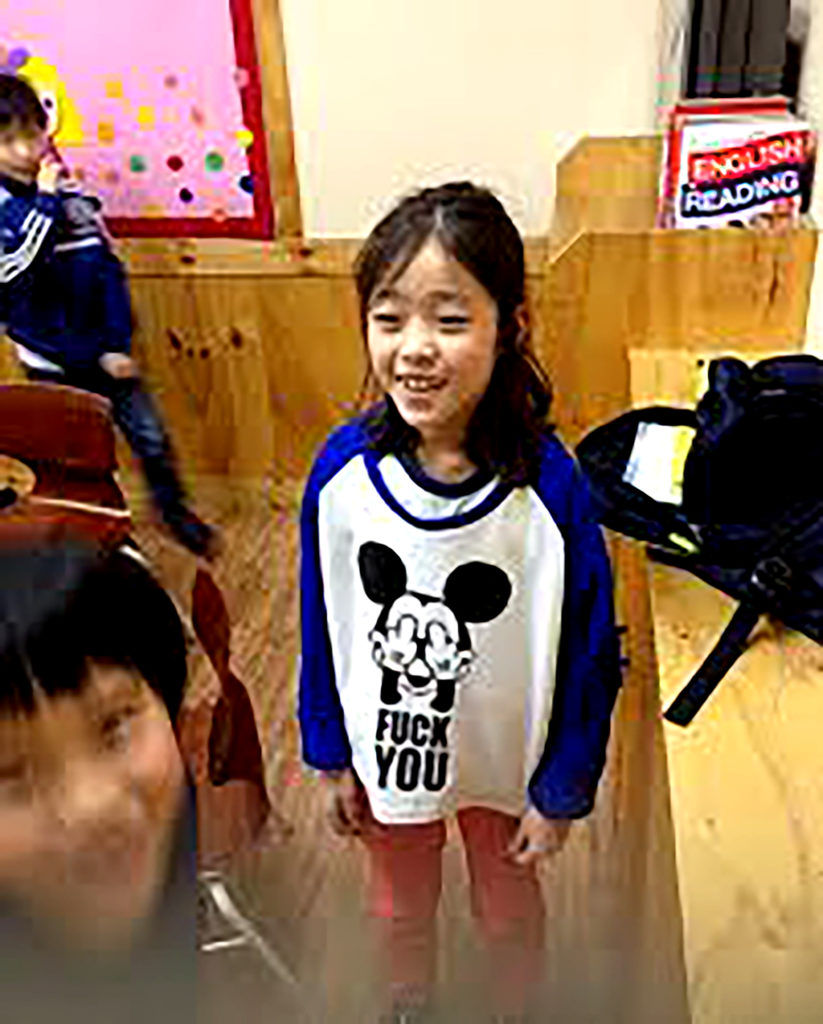
The little girl in this tee-shirt has no idea what this looks like to an American, nor did the grand-parents who might have bought it for her. It is simply a cute Mickey Mouse with an all-American attitude and thus ultimate in cool fashion with no offensive idea intended from the person wearing it. Most people seeing it would be Japanese and would think it was “cute”.
My observations of the cultural disconnect were especially true when it came to Japanese appropriations of the “American cute” with such imagery as Mickey Mouse or Little Black Sambo. I had not heard the theme song from The Mickey Mouse Club since early childhood when I watched it on TV with Annette Funachello. But upon moving to Japan, I heard it everywhere. Each morning I woke up to the blaring sound of The Mickey Mouse Club theme song, in Japanese, over the community loud speakers that were situated on top of electric poles throughout the town. The young and old would gather at 6am in a local school field to do morning calisthenics in unison to this song. “M-I-C-K-E-Y-M-O-U-S-E, Meecki Mousu, Meecki Mousu” would blare throughout the town over outdoor speakers that were also used for the daily community announcements, hurricane updates and… the 6am community calisthenics. Once a week I would also hear the same tune coming from the garbage truck and the sewage vacuum truck, which played from the truck speakers in the same manner as an ice cream wagon. In this case, it was used to candy-coat the true nature of poop and garbage with sweetness. Of course our culture is not so different with our cutsie blue Charmin toilet-paper bears that we think of when our business is at hand.
One day I ran into Colonel Sanders all dressed up as a Samurai over his Southern plantation attire. It was a bit like the time I watched Gone With the Wind with the voices of Clark Gable and his black servants dubbed in Japanese. It was like biting into a chocolate candy that I thought I was familiar with, only to be surprised by something inside that I had never tasted before. What made it all bizarrely absurd was that it was the mundane norm to everyone but me. It was easy to laugh at something like this but quite another matter to understand. One day I had a major epiphany when I unconsciously began to bow during a telephone conversation with the electric company, because I silently knew they were bowing to me on the other end. After that phone conversation, my new theme song was the The Vapors pop hit I think I’m turning Japanese. It stretches the imagination out of its little box to try and think Roman when you are in Rome – personal growth is a great way to survive amidst diversity.
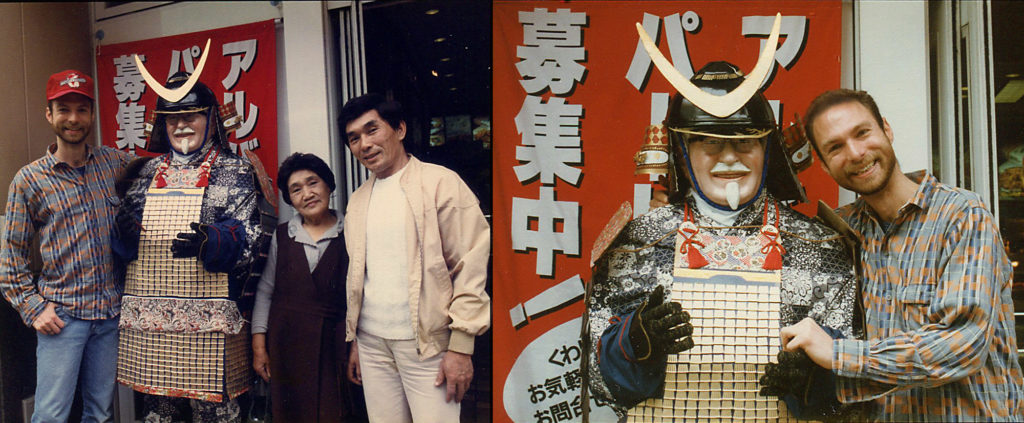
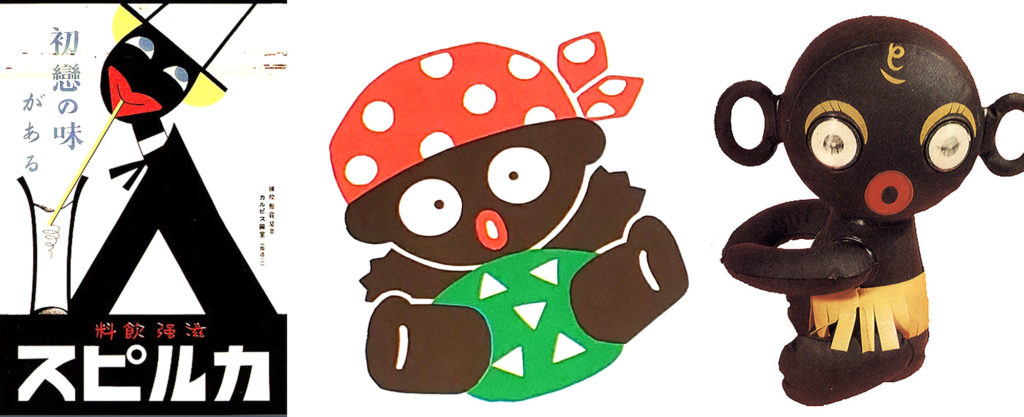
The racial stereotyping of blacks in Japan is starting to have some consciousness about it but Japan is a racially homogeneous country with strict bans on immigration. I saw perhaps four black tourists in my four years there (I was not in Tokyo) and usually the only people I ever ran into were Japanese. Most of the Japanese I knew had never seen a black person in real life but everyone knew Eddie Murphy from his comedy movies. Little Black Sambo is a very popular character in Japan. In the 1960’s the Takara toy company had its biggest mega hit with their plastic blow up doll “Dakko-chan” (roughly translated as “little huggy”). The company sold over 2.4 million of these dolls. This racist caricature of a little black girl became the company’s logo (more recently removed). How do you play with it? Well you don’t. You just wrap it around your arm, let it hug you and hang there. It became the hottest item in Japan and young women wore them as a fashion accessory, you could even see people wearing them at the beach. I often saw my students wearing Little Black Sambo ribbons in their hair and Little Black Sambo socks with “Afro” written all over them and racist caricatures of black people with round red lips and afros. Out of school I would run into girls dressed fully in Little Black Sambo print dresses with the Little Black Sambo ribbons in their hair with matching socks and bags.
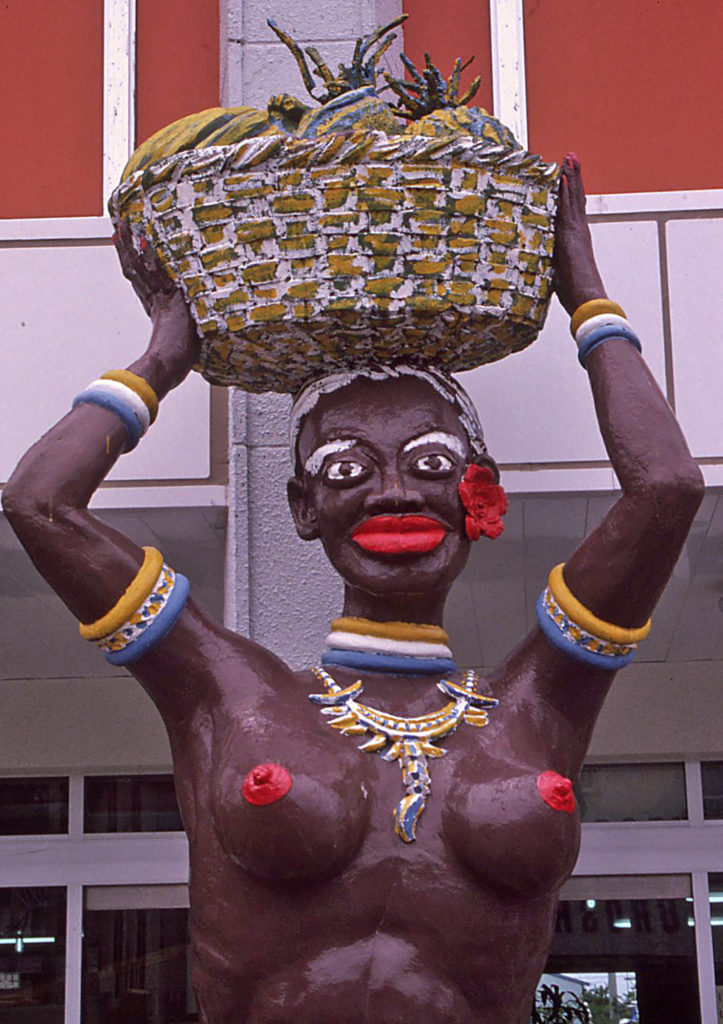
4. The Kawaii Culture of Cute in Japan
The word “Kawaii” is perhaps the most used word in the Japanese language and usually reverberates with the squealing intonation of “Kawaaaiiiiiii!!!”. It could be compared to the American overuse of the word “awesome” but is more complex, meaning “cute” or “too cute” or “lovely” or “lovable” or “adorable”or “pretty” and usually carries a connotation of smallness, shyness and innocence. There are also many implications that come with the word; it is not just a word for cute. Although it has connotations of shyness, embarrassment, vulnerability, darlingness and lovability, its darker aspects reference frailty and even physical handicap as a marker of adorability. The literal meaning of the word denotes “lovable” or “pitiable”. The cuteness culture, or Kawaii aesthetic, is a prominent aspect of Japanese popular culture, entertainment, clothing, food, toys, personal appearance, and mannerisms. It is imbued with subtleties which are not readily accessible to the casual foreign observer. The real meaning is, like many words, lost in translation and can only really be understood in Japanese from a cultural perspective. All of a sudden my deep ingrained sense of repulsion for gag-me-with-a-spoon, over-the-top cuteness became the hippest phenomenon on earth. Either I had to live with a new appreciation of the cute or go raving mad. I turned to my love of the kitsch to find a way out and formed a new appreciation for the infinite line of Miss Kitty products. Being embedded in the “Kawaii culture” opened new perspectives for me on the idea of “cute”.
Japan’s Kawaii culture is believed to have begun in the 1970s when teenagers developed their own childlike handwriting. This handwriting incorporated smiley faces and hearts that were added to curvy hiragana characters. As the trend grew, this type of writing became difficult to read and was banned by the Japanese educational system. It came back in the 1980’s when advertising took up the style to appeal to Japanese youth. Cute became a trend, and Kawaii went Japanese mainstream. During this time, many of the younger Japanese generation sought the comfort of cuteness to cope with the harsh realities of adulthood. I tend to think of it as coming from a similar mindset as the “Valley Girl complex” in our culture. In post-war Japan, the older generation did all they could to spare the next generation the difficulties they experienced during and after WWII. The result has been a generation spared nothing with many spoiled children not having the life skills to deal with adult life, responsibility, or reality (the phenomenon of gaming did not help matters). In the most extreme of cases, it developed into a cultural problem to the point of new words having to be added to the language in order to describe these new types of Japanese. The Japanese Ministry of Health, Labor and Welfare define “neet” as “people who are not employed, not in school, not a homemaker, and not seeking a job” and “hikikomori” as “those who are neither in work nor school, do not have social interactions and are socially withdrawn for more than six months.” In such cases, cute becomes a way of resisting and hiding from the adult world. Aside from not acknowledging the difficulty of life, the Kawaii culture has evolved into a very complex concept where its roots influence and manifest in anything Japanese. It has evolved to mean someone or something with no negative traits. It describes the culture of celebrating all things adorable as well as embracing fictional characters as the embodiment of positivity. Cute makes people feel needed and can make others feel like they are taking care of something helpless. Japanese teenagers use cute as a way to fit in with their friends. Japanese women often act cute to attract men, empowering a man to psychologically feel his macho protector and provider instincts towards a helpless female.
The present face of Kawaii was born in 1974 with the creation of Hello Kitty. Hello Kitty is one of the world’s most famous cats and today has over 50,000 product lines available in 130 countries. Hello Kitty represents Kawaii culture to a tee: a cute character with disproportionately big eyes and head, a small nose, and minimal facial expression. Her expressionless demeanor is what makes her so lovable, as it allows viewers to project themselves onto the character, making her popularity transcend age and gender. (The psychology behind Peeps is very similar.) The Japanese postal service has issued Hello Kitty stamps, thus bestowing upon it official approval and a national Japanese identity. Hello Kitty even has a line of menswear.

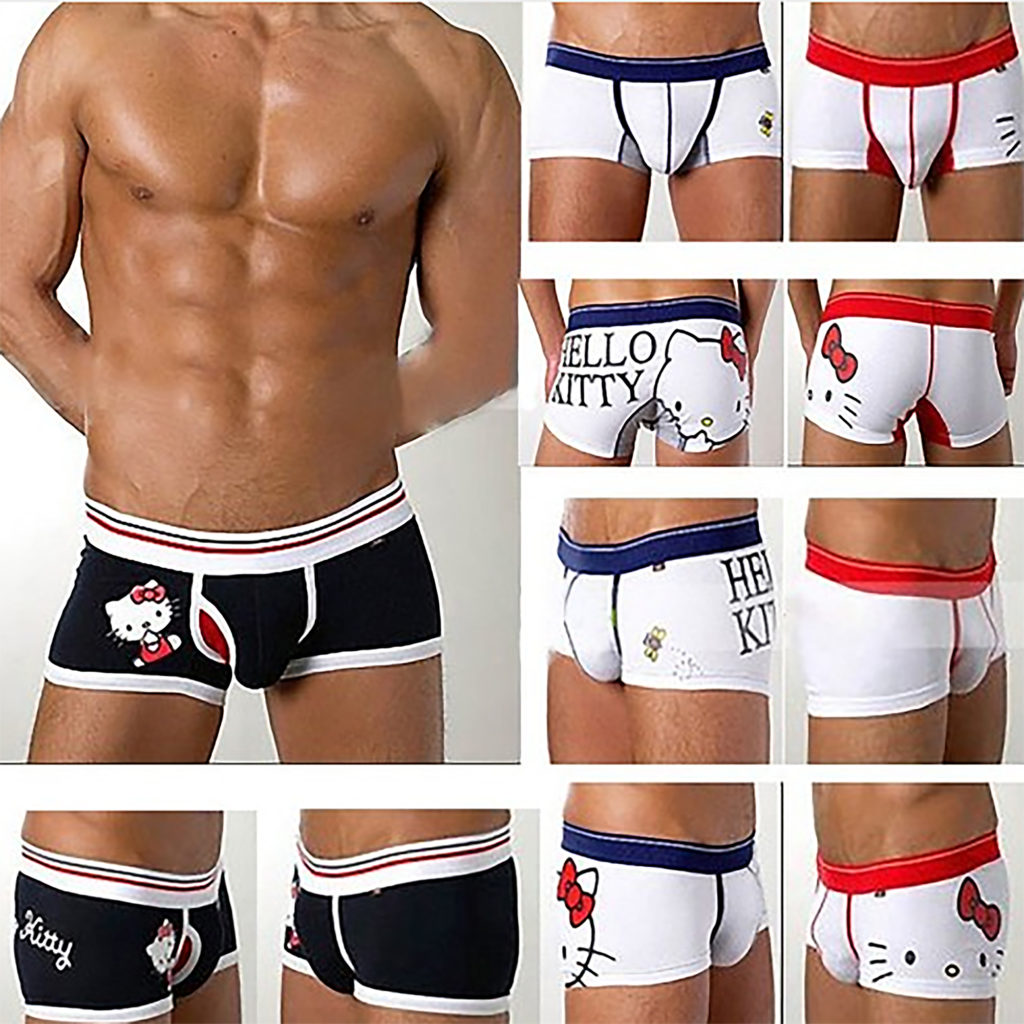
America’s cute, yellow smiley face icon found fertile ground in the heart of the Japanese Kawaii culture and in 1997 it was replicated into what we know today as “emojis”. “E-mo-ji” is a compound word that breaks down into “e” meaning “picture”, “mo” meaning character, and “ji” a suffix meaning a form of written language, or “a written character that is a picture”. Emojis were designed in Japan as a solution to the miscommunication that inherently exists with the new language system of e-mail, due to its short nature. The initial solution was 176 emojis representing a variety of human emotions which eventually evolved into the international emoji language system used today.

The whole of Japanese society has embraced cute. The cute culture is embodied in Japanese fashion, which focuses on cuteness and innocence. The kawaii revolution in fashion is usually referred to as the “Lolita” aesthetic and includes such things as bright, colorful, frilly clothes, overstated bows, lace, ribbons, bloomers, aprons, ruffled petticoats, parasols, heels, and Bo Peep collars. (The name has nothing to do with the Western novel by Nabokov but evolved out of doll fashion.) To complement this style, the Kawaii mannerisms are overly cute in an adorable, innocent, childish way. Lolita fashion is a very well-known and recognizable style in Japan. It can easily be seen with popular female singers, acting dramatically cute on camera with their almost ballet-like too-toos and huge bows in their hair. This cute style extends far beyond fashion though into the worlds of child-fantasy sex and porn. The cuteness of a giggling girl clad in a Hello Kitty jumper isn’t entirely innocent. The “Lolita complex” is the phenomenon of the little girl as sexual object. In some of the big cities, vending machines sell used schoolgirl panties, which the girls sell to the middlemen; this school girl fantasy abounds in the Japanese mafia-run sex industry. Aside from cultural sex ideas, the negative connotations of cute can also be seen as encouraging consumption on a mass scale. Keeping up with cute requires the masses to embrace the frivolous during the Japanese national pastime of shopping.
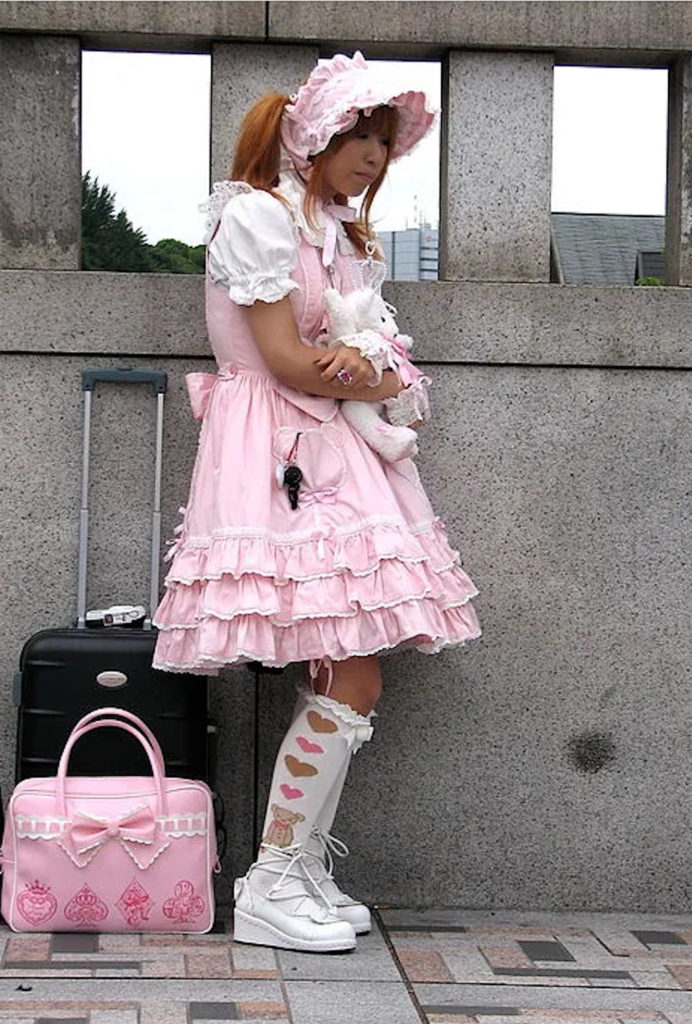
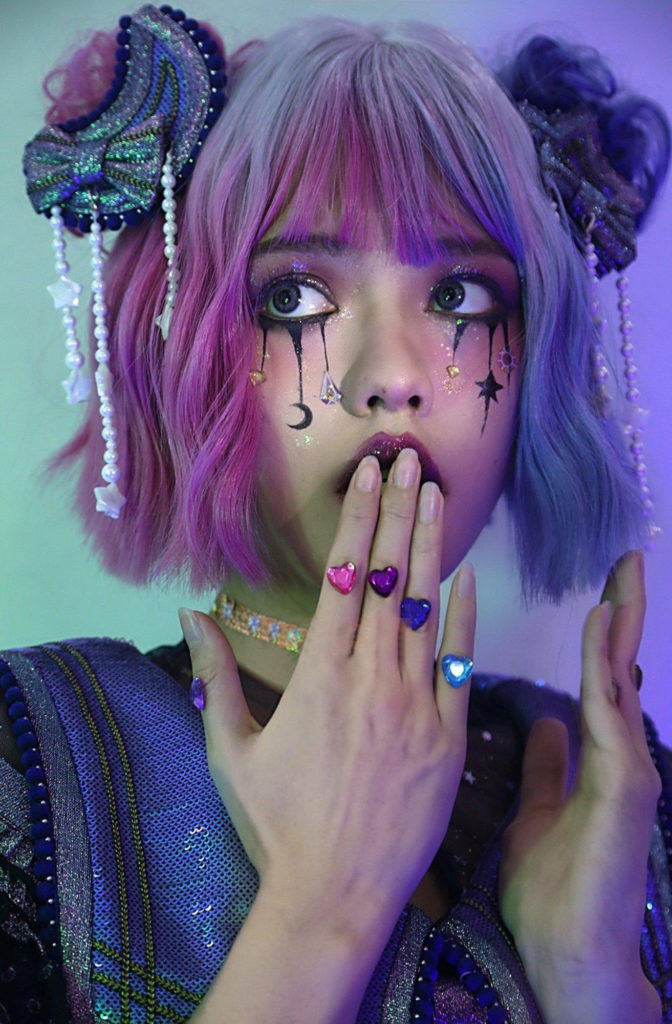
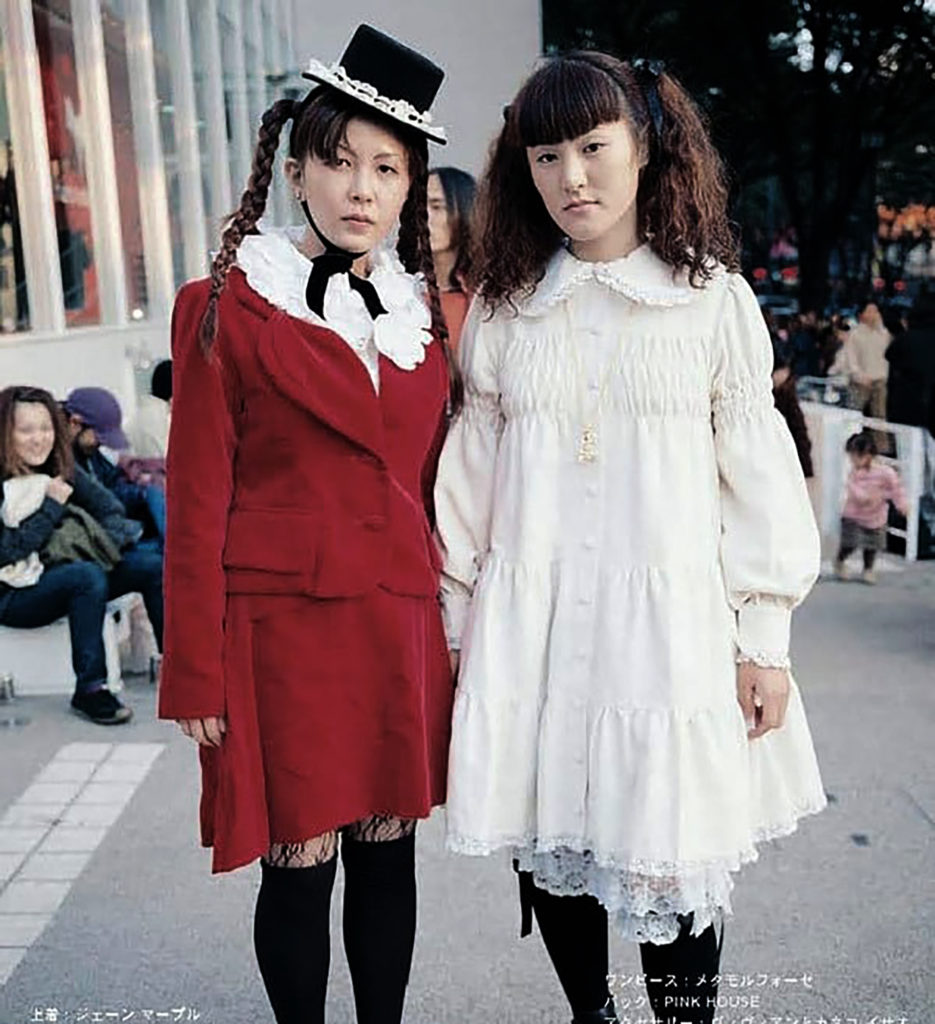
The influence of Kawaii culture can also be seen in mainstream anime with iconic characters like Totoro and Pikachu – totally Kawaii. Through planetary osmosis, these trends easily become appropriated icons that are embraced and adopted by American culture as well. As these icons take root in a new culture, they take on new meaning within their new context. Often these kinds of foreign ideologies are initially seen as threats to the existing culture, or seen as an Eastern invasion corroding Western tradition, but as time evolves, things like yoga or meditation become taken for granted as a part of everyday American life. When Pokemon first became a beloved rage amongst American children, many in the Christian church saw it as a conspiracy by Satan to take over the souls of our children. I personally had confrontations with people in my life who believed this. The following is a news article about an incident that occurred in a Colorado Springs church.
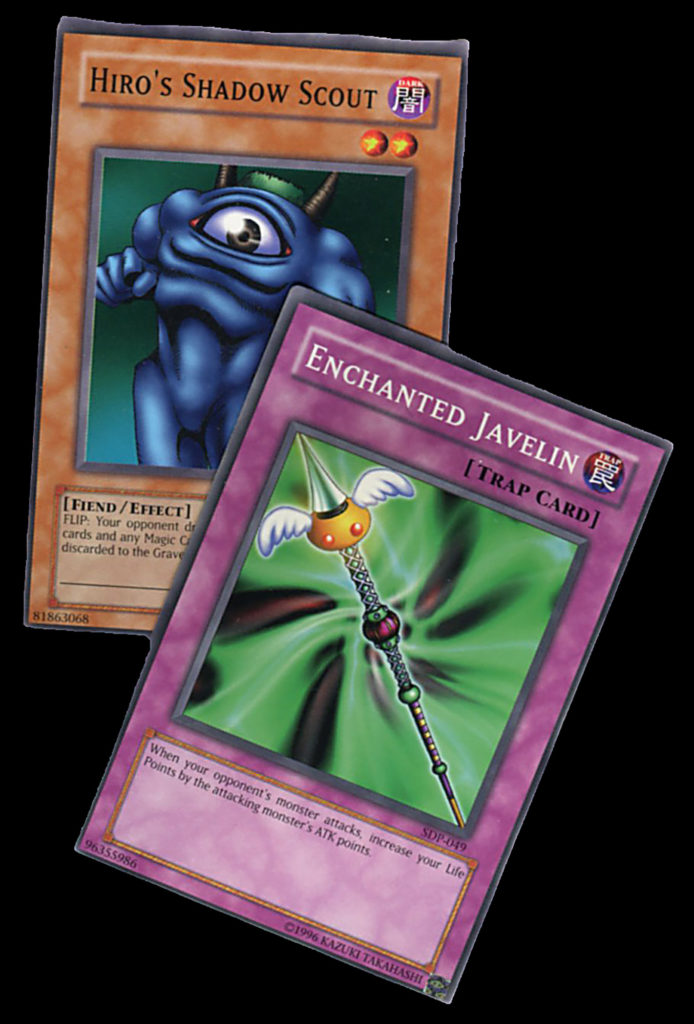


The Gazette, Colorado Springs
Grace Fellowship Church, 1999
On Wednesday night, the message to 85 children seated in pint-sized chairs was that a wildly popular Japanese-bred toy figure known as Pokemon is not fun and games, but instead a veiled symbol of the occult and evil.
To drive the point home, the children, ages 6 to 12, were given a display that included the burning of collectible Pokemon trading cards with a blowtorch and the pastor swinging a sword with a 30-inch blade to strike a plastic Pokemon action figure laid on a table with the pastor’s 9-year-old son tearing the limbs and head off his own Pokemon doll.
Those details were confirmed Thursday by Mark Juvera, the children’s pastor, and Mark Cowart, the senior pastor, in interviews with The Gazette. The children reacted enthusiastically and, according to one account, chanted, ”Burn it! Burn it!” and ”Chop it up! Chop it up!” Though the tactics might seem unusual, Cowart said he believes in the message and the method.
He said the 2,000-member, nondenominational church at 6540 Templeton Gap Road didn’t receive any complaints Thursday.
Juvera said he learned of the occult angle Wednesday after being sent an e-mail of an Internet essay written by a California woman, Berit Kjos. The essay alleges that the mania over Pokemon, short for ”pocket devils,” encourages role-playing that elevates children over God to the position of master, and that the games and toys are laced with dark satanic references.
Cowart said he had suspicions when one of his children showed him a Pokemon card with the word, ”abracadabra.” He said Pokemon also eggs on youth violence, because characters battle. And one character even sprouts horns, he said.
”Being Christians, we’re very cautious about this sort of thing,” said Cowart, who plans to toss his kids’ Pokemon toys. ”Really, these are lessons in sorcery and occult activity, even though it’s shrouded in innocence.”
That interpretation was a surprise to Holly Ingram, a spokeswoman with Hasbro, which makes Pokemon toys. ”I guess you can look at it and think whatever you want, but everything we’ve heard about Pokemon has been extremely positive,” she said.
Jenny Bendel, a spokeswoman with Wizards of the Coast, a Seattle company that sells the trading cards, noted that when Pokemon characters ”battle,” the loser doesn’t die, it faints. ”It doesn’t get any more nonviolent than that,” she said.
Cowart said the methods employed Wednesday were necessary to compete with Hollywood and cartoons. He said parents are told the church uses ”graphic, visual” lessons. The sword was used “because the Bible calls it the sword of God,” he said.
”We live in a sight-and-sound generation,” Cowart said. ”Linear teaching of the Bible is not gonna cut it.”
”You need to get them when they’re young,” he said. ”They can’t be worshiping these sorts of things.”
Regardless of such beliefs, to most American families Pikachu is now an icon that rules the beloved American landscape for young children alongside The Teletubies and My Little Ponies.
Kawaii keeps showing up more and more in the West, such as in our recent fascination with Marie Kondo and her tidiness religion, which is marinated in a strong flair of Kawaii. As exemplified by Marie, the Kawaii trend represents a total way of life for people who commit broad aspects of their days to living in a cute, adorable way. Marie Kondo’s reality Netflix’s series Tidying Up With Marie Kondo, and the disorganized American types she is paired up with, reminds me of Bambi vs. Godzilla except at this point in time, Bambi crushes Godzilla.
After being detached from America and submerging myself in Japanese culture for four years, my perceptions and attitudes toward the cute were forever changed. My repulsion towards cute mellowed. The multi-levels of American popular culture these days have room for, and embrace, just about everything out there. The humor that is a part of my perspective on life, is also multi-layered without apology; the complexity in which I think is a gray area that encompasses both the dark as well as the light simultaneously. Humor as a coping mechanism has become as complex and opaque as the complex and problematic world in which we live today and is reflected in the way I express my ideas through art.


Sarah
John, thank you. I’m speechless and in awe. I don’t have a clever response. This piece represents, to me, the full blooming of your life’s mission and message. Your chiseled character is in full view, sculpted from your innards over this lifetime.
Ivar
This is outstanding John and such a fun and informative read. Humor is the grounding force in life, or should be. Humorless people are not my cup of tea and it has always seemed that they are few and far between in the broader world of contemporary art. But it is such a personal thing too, its been a guiding force in my life for sure and your article brought back many similar memories and thoughts, some that were deeply buried (like Mad Magazine) and also made me think about those that were so important for me to get through childhood and also adult life. I was a huge fan of National Lampoon magazine, its hard to imagine there isn’t another publication like that in this day and age, it made me feel more mature as a teen and also provided exceptional material for humorous interp in speech tournaments, taking the jurors by surprise as everything else was so dull. I also loved Richard Pryor albums and memorizing his lines as a teen, something I think about these days as my son is around the same age. Monty Python was also a huge influence, as was Benny Hill! And I have to say the year that the Onion newspaper stopped circulating in print was the saddest day of my life, I revered their “fake news,” and even though it still exists, its just not the same for us old timers that prefer their intake in print, not to mention having to go seek the latest issue out on some street corner. I still watch South Park religiously (yes, humor is my religion) and find it sad that there’s not nearly as much media that can stimulate in that same capacity, though it is out there. All I can say is that humor is the only thing that might save us as the world goes to hell in a hand basket! Cheers and looking forward to Part 2
carol b.
I love this blog post so much, John! And it begins with that incredible egg photo! Very cool subject matter and such interesting perspectives offered. When I was in sixth grade, I was a dead-ringer for Alfred E. Neuman and I’ve got the school photo to prove it! One of my favorite parts of the magazine was to fold the back cover and see the hidden photo. Can’t wait for the next installment!!
Hiroko Hansen
Such an insight into the culture, educational and thoroughly enjoyed it.
Sharon Brown
You are a wonder. This is beautifully written ,insightful, educational, enlightening, hilarious…those tee shirts!
Thank you for sharing this. I’m passing it on to discerning people!
Rex Brown
Wonderful! Thanks for reminding me of my youth in the forties and fifties and then humorously teaching me about some Japanese contemporary perspective, which I’ve never had an understanding of.
Rupert
This made for excellent morning reading, John – thanks! The Japanese t-shirts are wonderful and shocking and the whole Lolita thing is, well, very strange to me. How successfully humor crosses borders is a fascinating discussion. As a Brit I realize that my own humor is often perplexing and occasionally disturbing to people not attuned to it, which probably explains why my best friend is also a Brit. I have learned the hard way to quell my sarcasm (the root of British humor alongside self loathing and farts) and to keep my mouth shut on most occasions!
Timothy Batton
John. Thank you for creating and sharing this cultural statement. I found your creation thought provoking and enlightening. The humor is obvious but the message was penetrating at many levels. I am Blessed you are thinking of me and you are my life long friend.
Sue Hunt
John,
This blog was an absolute blast to read! It was funny yes, but mostly I was fascinated to read about the history of humor and then revisit the 50’s, 60’s, 70’s and forward, which was my growing up period too. We forget about those things. Interesting to hear that humor in your life stems from your dad. Humor can help us develop a healthy perspective in life to move through the challenges, for sure.
Who thinks about all the kinds of humor, from the ancient, the TV and other media from our phases of growing up, Mad Magazine, dry humor to the kind that wrings your stomach a bit. I did not know the true source and meaning of “ring around the rosie”, and won’t forget it now. There is always something new to learn from you, John!
Your exploration of cute was also something I had never considered – Hello Kitty really did take on a life of her own and I did not know that Pikachu came from Japan. The T-Shirts were so funny! All those “cute” kids and other unsuspecting individuals walking around with English profanity on their clothes. Thank you for sharing your travel and experiences in Japan. I haven’t traveled much myself really enjoyed reading about it.
This was another well written and totally captivating story from your life. Wonderful!